There are two plaques on the wall of the editor-in-chief’s office in The Heights’ newsroom that list every student who has ever led the paper. The plaques serve as a constant reminder of the history of this storied paper and the obligation that the current editors have to preserve this organization and its mission.
In order for the current board to fulfill its obligation to uphold the quest of this publication, The Heights will be ceasing its print operation at the conclusion of this academic year and will become an entirely digital newspaper beginning in the fall of 2021.

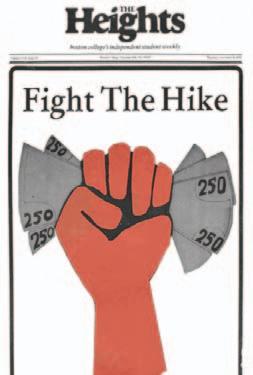
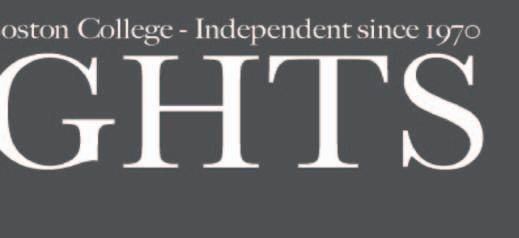
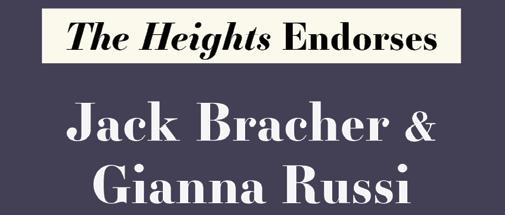
The Heights’ transition to a fully online newspaper is the culmination of years of work from past student boards, and it is an effort to remain ahead of emerging trends in student and professional journalism.
In recent years, the paper has scaled back its print production and expanded its online presence through newsletters, social media, and its website.
Our new eEdition will be the cornerstone of our online presence while we will use the aforementioned media to continue to tell the stories of Boston College. The print edition has been the basis of our journalism for the last 102 years, but our online presence will be the foundation of the next 102.
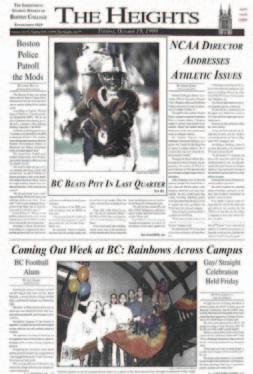
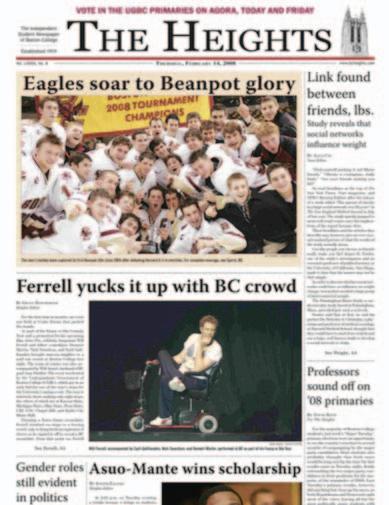
Our new eEdition will include the same strong journalism and eye-catching layouts that The Heights has become known for in print. Now, the excellence of our print edition will be available

to everyone, wherever they are, every Monday. We hope that you will subscribe to our eEditions to see for yourself what strong student journalism in the digital age looks like.
I am sure that this decision comes as a shock to some of our readers, alumni, and parents who have faithfully read The Heights for decades. I assure you that this decision was not made lightly and that we understand the impact this may have on members of our community.
The days of copies of The Heights being strewn across tables in McElroy Commons or piled high in the corridors of Gasson Hall are in the past. The Heights must now look to the future to ensure that it continues to be an institution of BC for the next generation of students.
The choice to discontinue our print edition is more than a financial or editorial decision. It is a commitment to the original mission of this paper: For a Greater Boston College. I am confident that this paper will endure, as its founders intended it to, for the next century due to the exceptional editors who come through this newsroom and the courageous decisions they make.

The first editorial ever penned in The Heights stated that “optimism will prevail in its editorial rooms.” A lot has changed in the century since that editorial was written, but the optimism in our office in McElroy Commons has remained the same—even now as The Heights is set to stop printing.
The decision to cease printing was not one made by a board hamstrung by the decline of print newspapers and struggling to function. It was a decision made by a group of idealistic student journalists who believe in the power of student journalism and are committed to taking the necessary steps to ensure that independent journalism is alive and well on the campus of BC for years to come.
Although an undeniably dramatic change to our operations, the current student editors are not dejected by our transition. Instead, we are excited by the opportunities available to us in this next chapter. We hope that no matter how sad you are to see our print edition go, you will join us in the optimism and excitement we have for the future.
Lastly, thank you to everyone who has read, donated, and sent messages of support to us over the last century. We hope you will continue to support us in what promises to be an exciting time.
The board and I are looking forward to this next phase for The Heights, and I hope you are as well.
Fahy Editor-in-Chief

UGBC Holds Debate In Lead Up To Election
role he believes student activism plays in the successful functioning of a student government.
A ND B RANDON K ENNEY Heights Staff
The four candidates for president of the Undergraduate Government of Boston College—Spencer Sandusky and Kevork Atinizian, both CSOM ’22, and Urwa Hameed and Jack Bracher, both MCAS ’22—met for a final debate on Sunday ahead of Tuesday’s election.
The candidates debated in person while the audience attended virtually v ia Zoom webinar. Due to COVID-19 restrictions, the vice presidential candidates were unable to participate in the debate.
Each of the candidates addressed distrust in UGBC among the student body. Hameed said that UGBC needs to address its systemic issues and become a proactive organization in order to gain students’ trust.
“In the wake of any social issues, students and student organizations call on UGBC to address the systemic issues,” Hameed said. “UGBC needs to transform from a reactive student organization to a proactive student organization. It needs to change from being cautious to being activist.”
Bracher spoke to the important
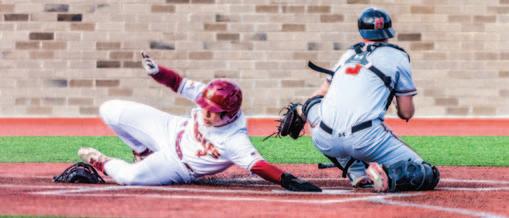
“Fundamentally, UGBC is the vehicle for the will of the student body, and therefore the success of any UGBC president or vice president depends on their ability to translate students’ frustration and anger into tangible change,” he said.
Sandusky, who has never held a position in UGBC, said he and his running mate would bring a new perspective to the organization.
“I want you to ask yourselves in the past year, what difference has UGBC made in your lives?” he said. “Can you really see a tangible change in how you go about things and how your Boston College experience has been shaped?”
Bracher said that UGBC simply needs to do more to regain students’ confidence. He proposed creating an environmental sustainability division within UGBC to pressure BC to divest.
“The environmental sustainability position in student initiatives isn’t cutting it,” Bracher said. “That’s why we need an environmental sustainability division—to not only pursue divestment but also short-term, tangible solutions towards reducing waste on campus.”
Sandusky asked why the candidates have not already brought up the changes they are proposing while serving in their current positions in UGBC.
BC Professor Accused of Sexual Assault
sexually assaulted her twice—on Halloween and in early December of 1987—while the two were students in a theology doctoral program at Notre Dame.

“I will come to you in this series of videos reflecting on ecclesial rape culture in which you so strongly enable and perpetrate,” Grimes said addressing Gaillardetz in the first video.
Gaillardetz, who denies the allegations, has voluntarily stepped away from his teaching and administrative duties at BC while the investigation continues.
In an email to The Heights , Gaillardetz said that he first learned o f Grimes’ accusations on Jan. 23. BC has hired an independent law firm to investigate the credibility of the allegations—an investigation that is still ongoing—he wrote.
“I am eager to set the record straight with respect to Dr. Grimes wreckless allegations but I have been advised not to respond to the allegations until the investigation is concluded,” Gaillardetz wrote.

INSIDE THIS ISSUE MAGAZINE: Nancy Mignosa Nancy Mignosa, BC ’86, participated in the Pfizer vaccine trial......................................... A4 NEWS: Black History Month As Black History Month comes to an end, the BAIC reflects on celebrations.......................... A2 INDEX Vol. CII, No. 4 © 2021, The Heights, Inc. www.bcheights.com BASEBALL SPORTS
2019. A11 ELECTIONS EDITORIAL The Heights believes Bracher and Russi will serve UGBC best out of all four teams. A6 See UGBC, A2 B Y M EGAN K ELLY News Editor J ULIA K IERSZNOWSKI Assoc. News Editor A ND V ICTOR S TEFANESCU Asst. News Editor
BC Baseball beats Duke 5-2 in its first series win over a ranked opponent since
Boston College is investigating allegations that Richard Gaillardetz, chair of the theology department, sexually assaulted a former classmate at the University of Notre Dame. In two YouTube videos released on Wednesday and Jan. 23, theologian Laura Grimes alleges that Gaillardetz
B Y E MMA D AWSON Heights Staff
See Gaillardetz, A3
NEWS......................... MAGAZINE.................. OPINIONS.................... METRO.................. ARTS.................... SPORTS................... A2 A4 A6 A8 A9 A12
Sincerely,
Letter From The Editor: ‘The Heights’ To Cease Printing Eliminated. See Women’s Hockey, A11 Monday, March 1, 2021 The presidential election will be held on Tuesday.
Owen
BRIEFS
Local Artist Transforms Tree
Boston College commissioned Ken Packie, a Massachusetts artist who specializes in wood sculptures, to carve a three-dimensional sculpture of the Holy Family out of an ailing oak tree, according to a University release.
The oak tree, which is located on BC’s Brighton Campus, is centuries old and has been declining for a decade, according to the University release. It will be removed this month.
“I could imagine, historically, before they cut Commonwealth Ave. through, there were probably many more of these oak trees, and this one happened to survive,” Regina Bellavia, director of Landscape Planning & Services, said. “I’m grateful we were able to witness it for this long.”
When the tree is removed, the release said one lane of traffic on the westbound side of Commonwealth Ave. will be closed and a temporary sidewalk will be constructed.
Packie has also carved a sculpture of a marathon runner from a dying maple tree in Newton, according to the release.
“As a three-dimensional story teller, I strive to capture the fine details as well as the interactive dynamics within my sculptures,” Packie said in his artist’s statement on his website.
According to the University release, Packie uses only three tools to create his artwork—a chainsaw, chisel, and blowtorch.
“It’s an evolution as the piece unfolds,” Packie said in a documentary about his work. “[I’m] taking something that was alive and giving it a second life in a different form.”
Lee Talks Race, Health
BY BRANDON KENNEY Heights Staff
Korean-American author Min Jin Lee gave a lecture Wednesday night that discussed her experiences with race, failure, and disease as part of Boston College’s Lowell Humanities Series.
After graduating college and law school, Lee became a corporate lawyer but quit after only two years, as she said the job was not fulfilling for her.
Lee faced issues with health throughout her life, as her Hepatitis B diagnosis made her prone to liver diseases. She said an uncertain future inspired her to follow her dreams as a writer.
“If I had not known about my liver disease, I wouldn’t have thought so carefully about how to spend my time,” Lee said.
Lee initially found little success. Her first attempt at a novel failed.
“It was titled Revival of the Senses and the very best publishers in New York rejected it,” Lee said.
After Lee moved to Japan in 2007, she wrote another novel to more success. Writing Motherland, which is about the Korean-Japanese population in the country, she came to a greater understanding of the group.
“The Korean-Japanese people had suffered institutional discrimination, and they were deprived of basic human rights,” Lee said. “However, they did not see themselves as victims, and they told me that they were just ordinary people and they wanted only to have normal lives and to be treated fairly.”
At the end of her talk, she reflected on how failure played a central role in her development as a writer.
“I have failed for far more many years than I’ve succeeded if I had succeeded at all,” she said.
BAIC Closes Out Black History Month
B Y M EGAN K ELLY News Editor
In a typical year, the Thea Bowman AHANA and Intercultural Center (BAIC) kicks off Black History Month with a large opening celebration stocked with student performances, guest speakers, food, apparel, and music.
But the annual celebration, like many others this past year, had to be moved online.
“This year was a little different,” Danielle Date, an assistant director at the BAIC, said. “So we had our opening celebration via Zoom. We had about 100 attendees at one given time. … And then on the Friday we had a grab and go lunch.”
Date said that although the format of this year’s celebration, which featured associate professor of French and African and African Diaspora Studies Régine Michelle Jean-Charles, was a little different, the overall message was the same.
Highlighting Jean-Charles, a powerful Black woman in the Boston College community, the event in early February was fitting following the incidents of vandalism and harassment on the Multicultural Learning Experience (MLE) floor of Xavier Hall, Date said.
“She focused her talk on Black joy and especially what happened on the MLE floor,” Date said. “So you know it’s kind of fitting, what happened in that recent time, and just empowering the community, especially Black females.”
Date said that the Black History Month Committee wanted a Black woman to be the keynote speaker at the celebration and was initially looking to get an outside speaker for the event. But Jean-Charles felt more personal, Date said, as Jean-Charles is
familiar with BC’s students, culture, and campus.
“We realized we have so many powerful Black women here on campus, and we realized like, ‘Why don’t we use Régine?,’” Date said. “All students of color really respect her and she has such a powerful presence on campus.”
Date said that this year, the BAIC’s themes for Black History Month were ‘Celebrating Black Joy’ and ‘Stronger Together.’
“We wanted to not only look at the trauma and the burdens that Black people face,” Date said. “[But] also look at the positives, the joy, the accomplishments of our students [and] of the Black community because sometimes we just focus on those negative things. We wanted to spread that message of uplifting.”
To spread this message, Darnell Fils, MCAS ’22 and co-chair of the Black
History Month Committee, said that each day of the month the BAIC social media platforms featured a BC student who would define what Black joy meant to them.

“You saw all the events that happen during the summer, and even throughout our lifetimes as well, and it’s always shone like a bit of darkness, a bit of despair,” Fils said. “But at the end of the day, just showing that Black people are still happy. They’re still resilient.”
Though the BAIC office itself, which Fils said is usually full of people, does not have as many visitors this year due to social distancing requirements, the office is still highly involved in the BC community.
“I think the office has done a great job of still being engaging and still being active,” Fils said. “There is still academic advising provided by the administrative directors and associate
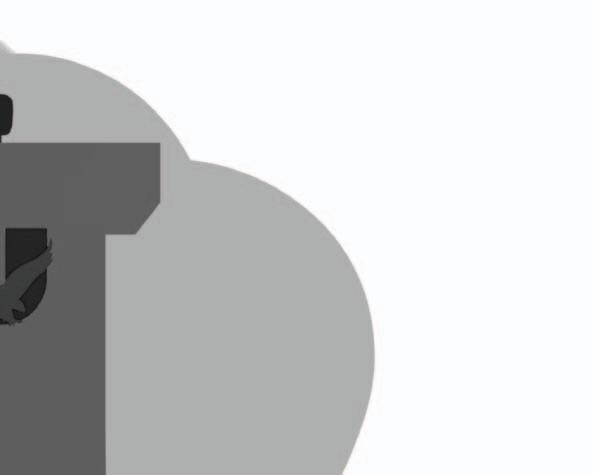
directors. There’s the food events that encourage people to come into th e office to just come by, say hi, pick u p their food.”
Both Date and Fils emphasize d that although Black History Mont h is coming to an end, the themes an d messages they promoted will still b e relevant afterward.

“Black History Month is only February, but continuing to spread thes e messages throughout the year, yo u know,” Date said. “We’re Black ever y day, right. It doesn’t change.”
The committee hoped to drive home the idea of being Black and proud o f who you are, Fils said.
“Black joy is an act of resistance and also a force for healing,” Fils said “It means that even if society doesn’t respect you or accept you for who you are, you still love yourself too much to b e affected by other people’s opinions.”
UGBC Candidates Face Off in Final Debate
area so that students’ needs can be addressed immediately and adequately.
“Everyone here has had their chance and nothing has changed,” he said.
The candidates also discussed Atinizian’s proposal of the creation of a bar and restaurant on campus. While Atinizian said it will improve student life on campus, others claimed that such a proposal should not be a priority while BC is facing many other issues.
“Advocating for an on-campus bar [and] restaurant has been done before at BC,” Atinizian, current UGBC vice president, said. “It’s looking at the current spaces we have in terms of how we can make sure that such spaces really interact with the student body.”
Something Bracher praised the current administration—led by Christian Guma, UGBC president and CSOM ’21, and Atinizian—for are the video updates early last semester regarding COVID-19 policies.
Bracher said he plans to build on that idea by working with Douglas Comeau, director of University Health Services, to produce Zoom webinar COVID-19 check-ins once or twice a month.
“I think it’s a win-win,” Bracher said. “You get a more informed student body, and you get a more transparent administration.”
The candidates also discussed the need for gender-neutral housing and
a student leader that one always has to be pro-queer, pro-AHANA+, pro-accessibility, because that’s our job,” Atinizian said. “It’s making sure that at the end of the day, students know that they could be supported and gender-neutral bathrooms are part of that.”
Sandusky said a focal point of his campaign is using precedent from other universities that share values with BC to enact the same changes they have made.
He also advocated for the removal of outdated restrictions from the code of conduct so that administrative attention may be redirected to more pressing issues, such as hate crimes on campus.
“What that includes is enacting our
“We’re going to do everything we can to ensure that any decisions we make … are in the best interest of students,” Bracher said. “If that may run contrary to Catholic theology, I know that at the end of the day, Gianna and I are going to be representing the students’ best interests.”
Hameed discussed her proposal to create an all-women networking platform.
She came up with the idea by speaking to various women’s groups on campus, looking at their networking programs and seeing how they are underutilized and could benefit from collaboration, she said.
“We want to bring in all of those student organizations together, and their resources together, and their mentors together to create a comprehensive system that can empower women here at Boston College,” she
d
respon
-
h
f t h e MBTA—to improve th e l ives o f BC stu d ents.
“All of those are reasonable,
A ll o f t h ose are reasona bl e, tangi bl e, an d simp l e goa l s t h at we can get d one b y t h e en d o f our a d ministration,” San d us k y sai d.
San d us k y a l so d iscusse d h is p l ans to use UGBC f un d ing to expan d University Counse l ing Services, ack now l e dg in g b ac kl o gg e d wait times
knowledging backlogged wait times, among other issues, that students are currently facing.
In the meantime, he said his policy is focused on outsourcing counseling to other institutions in the Boston
bathrooms on campus.
Atinizian said that he will pressure the administration to pursue these policies.
“I think it’s an important job as
College’s Code of Conduct.”
Bracher mentioned that UGBC needs to advocate for students’ best interests, even if it goes against BC’s Jesuit and Catholic mission.
i



h
d
h e
t h
Atinizian responded to her proposal by mentioning how he wants to move matters regarding women and gender from Student Initiatives to the Diversity and Inclusion (DI) division
Diversit y o f UGBC Th is is j ust to ensure th at in terms o f an d misman -
“This is just to ensure that in terms of miscommunication and mismanagement, that everything in terms of intersectional projects goes Sandusky finally discussed how his platform is directly built upon the needs of the student body and how he plans to listen to student voices while creating future proposals.
ement, t h at ever yt h i ng in terms o f intersectiona l t h roug h DI,” h e sai d San d us k y f ina ll y d iscusse d h ow h is p l at f orm is d irect l y b ui l t u pon t h e nee d s o f t h e stu d ent b o d y a n d h ow h e p l ans to l isten to stu d ent voices f uture proposal s. I t h in k t h at h as ten d enta lk to t h e stu d ent b o d y rat h er t h an open a d ia l ogue wit h t h e stu d ent b o d y,” San d usk y sai d We want th is to b e l isten to w h at yo u h ave to … an d th en we want to go ab out an d ma ke th e ch ange
“I think that UGBC has a tendency to talk to the student body rather than open a dialogue with the student body,” Sandusky said. “We want this to be a two way street. We want to listen to what you have to say … and then we want to go about and make the change that you’re telling us.”
Voting begins at midnight on Tuesday and will close that evening at 6 p.m.
THE HEIGHTS A2 MONDAY, NOVEMBER 11, 2019 TOP things to do on
this week 3 NEWS
campus
1 2 3
The Boisi Center for Religion and American Public Life is hosting “Three Pieces of Advice to President Biden from Catholics in the Public Square” on Thursday at 3 p.m. over Zoom. Panelists will offer advice to Biden on dealing with abortion and other issues in Catholic communities.
A tech and entrepreneurship career fair will be held all week for students looking to network with tech companies and start-ups. More information about the event can be found on BC’s webpage, “Start@Shea T&E Fair.”
Reena Parikh, an assistant professor at BC Law and BC ’06, will present “Workers’ Rights are Immigrant Rights: Supporting Low-Wage Immigrant Workers” on Tuesday at 12 p.m. At the Zoom webinar, she will talk about her time working in federal immigration law.
MONDAY, MARCH 1, 2021
UGBC, from A1 yy H ameed said that BC must p rioritize attem p ts to make sure AHANA+ students feel comfortable on cam p us. She also p romised to mark the success o f h er a d ministration b y t h e comfort level s of AHANA+ students on campu s “ I t h in k rea l c h ange wi ll h appen on Boston Co ll eg e’s campus w h en every AHANA+ is assure d in t h eir person t h at BC is enacti ng a z ero-to l erance po l icy to h ate crimes a n d racism ,” Hamee d sai d San d us k y propose d t h re e c h an ge s—improvements to BC d ining services, f ree appare l, a n d f ree use o
OLIVIA CHARBONNEAU / HEIGHTS EDITOR
p olicies and the transp arenc y behind that,”
y sa id “W ha
th at
is l ega l izing sex, w
ic
is s ti ll
ac tu al restriction on Bo st on
gg divestment
Sandusk
t
i s
h
h
a n
women
m entors toget h er to create a co mp re h ensive system t h at can empower
h ere at Boston Co ll ege,” s h e s ai d
d e
to
er pro
p osa l b y
ow
wants to m ove matters r eg ar d
ng women an d g en d er f rom Stu
ent Initiatives to
e
ag
MEEGAN MINAHAN / HEIGHTS EDITOR
Yik Yak, Snapchat, Yolo, Ask.Fm, and now, Herrd. There seems to be something so enticing about the ability to post anonymously.
“It’s a tight knit community I’d say, even though it’s anonymous,” Isaiah Mathieu, co-founder of Herrd, a new app for Boston College students, said. “For example, if you go and scroll through the app you’ll see a bunch of posts and the majority of them, they relate to BC in some way, shape, or form. So, it’s sort of like, ‘If you know y ou know.’”
Herrd co-founders Mathieu and Carter Beaulieu, both BC ’20, began working on an app during their senior y ear at BC in order to help people learn more about what events were happening in their area and who would be attending them.
When the COVID-19 pandemic hit and there were no longer events taking place, Mathieu and Beaulieu had to shift their plans. Their solution? A platform where BC students could communicate anonymously.
“COVID was sort of a blessing in disguise, because after we all got booted off campus the second semester of last year, Herrd, I feel, has allowed students to stay connected,” Mathieu said.
Herrd has about 2,000 sign-ups and 500 active users, who anonymously post questions, memes, or anything

that’s on their mind. Other users can up or downvote a post—somewhat akin to likes or dislikes on other social media platforms—and can comment and chat with each other.
“It’s all anonymous, so at the end of the day if your post gets upvoted you can just feel good inside, but there’s no superficial stuff,” Beaulieu said.
Though anonymous online communities are not a novel concept, Beaulieu and Mathieu wanted to make Herrd distinctly different in their approach to safety and the monitoring of posts.
All Herrd users must have a valid BC email to use the app—a move meant to make it easier for the founders to trace harmful or hateful content back to whoever posted it.
Though the veil of anonymity might encourage people to post something offensive, Mathieu and Beaulieu believe that having students’ emails connected to their profiles makes them think twice before posting something negative.
They’ve only received one incident so far in which a student’s content violated Herrd’s terms of service, and the user’s account was subsequently suspended. Mathieu and Beaulieu also said that if they deem content harmful enough, they would consider getting the BC administration involved in the case.
Though Mathieu and Beaulieu are always on the lookout for reports of offensive content to make sure Herrd is a safe and welcoming online community, students have still been enjoying the app.
The co-founders said that the most trendy posts right now are jokes and discussions about the Undergraduate Government of Boston College presidential election and Kirkwood Cookies, a student-run company that delivers cookies to the BC community.
Students using the app have been forming new connections— something Mathieu and Beaulieu are proud of,
now, they hope that Herrd can one day expand to other college campuses, or even beyond, incorporating event information from their first app, anonymous chatting, and other new features.
“I think it can be kind of your all-inclusive hub to understand everything that’s going on and ask questions and do stuff like that,” Beaulieu said.
The partners said that they are utilizing different promotional strategies to grow Herrd’s user base.
Mathieu, who primarily handles the business end of the project, said they use social media, student ambassadors, and partnerships with local businesses as avenues to grow.
I started to see people posting about it that I didn’t even know, people on their Snapchat stories were like, ‘Oh my gosh, I can’t believe this app is free,’” Gottbetter said.
Part of making Herrd sustainable is securing revenue, Gottbetter said, so he helps Mathieu and Beaulieu make connections with local businesses and potential advertisers.
Beaulieu says they’re hoping to utilize the app’s pinned post feature to help connect students with promotional content.
new features to be added to the app.
Though Mathieu and Beaulieu both have full-time jobs and have to manage Herrd on the side, they’re planning to launch a messaging function soon so that students can connect with each other one-on-one.
Looking to the future, Beaulieu and Mathieu said that they are excited for what’s to come. Though BC is functioning like a test community for
Josh Gottbetter, a student ambassador for Herrd and CSOM ’22, helps Beaulieu and Mathieu stay connected to what’s happening on campus. He said that he provides context for topics that students are talking about on Herrd, helps advertise the app on social media, and monitors posts for negative content.
Though he’s seen conversations become toxic and overly political at times, Gottbetter believes in the app’s mission and thinks students really enjoy having access to a community like Herrd.
“I think the coolest thing was when
“Currently, a lot of those messages are just like icebreaker questions that get people to reply,” Beaulieu said. “But eventually, we’ll have local venues or local restaurants, whatever, promoting on that pinned post, and they can offer a promo code code or discount code so then students can see that post, we can reach all these students using the app and it’ll be a win-win for whoever’s kind of promoting there and then for us as well.”
Mathieu and Beaulieu are excited to watch Herrd grow, and hope that in the COVID-19 era and beyond it will be a place where users feel comfortable sharing their opinions, jokes, or questions in a safe community of students like themselves.
“It’s a good way to just stay involved and stay in the loop of things when you can’t really see a lot of people face to face,” Beaulieu said.
Theology Department Chair Accused of Sexual Assault
said or watching what he said, it was so totally flawed and clueless … he’s everything he’s pointing the finger at.”
In an interview with The Heights Grimes said that she and Gaillardetz became friends while they were in the Notre Dame graduate program together, but their relationship did not progress further than friendship.
“We did a lot of spiritual sharing and had a very growing and new friend relationship, but no dating at all or romance,” Grimes said.
Grimes said one of the reasons she is coming forward with the allegations now is because she heard Gaillardetz, a professor of Catholic systematic theology, speak about the sexual abuse scandal in the clergy.
“I think I Googled him or something looking for his website, and what came up was that in the last couple years, he is speaking on literally the clergy sexual abuse crisis,” Grimes said. “And it was like, ‘Oh my god, utter blasphemy,’ and then reading what he
Gaillardetz spoke at BC in 2018 about reconciling with faith amid the sexual abuse scandal within the Catholic Church.
“And so at the end of the day, we consent to be troubled by the failings of the church, we consent to be troubled by its institutional dysfunctions, and we are determined to do everything we can to address those things,” Gaillardetz said at the event.
Grimes said that Gaillardetz is an example of one of the problems she sees in the Catholic Church.
“So just the whole moral bankruptcy, the spiritual bankruptcy of the entire Catholic theologians and Catholic universities that are, instead of cleaning up their own house—their very serious problems—they’re instead pretending they’re the heroes
and they’re gonna save us from the bad bishops and the bad priests,” Grimes said.
Grimes also said that she is coming forward now because she has come to understand that her alleged encounters were abusive.
“Over the past several years, I’ve started to see more and more what he did to me was really horrible and was not consensual and realized, ‘Oh, I need to speak out about this,’” she said.
Grimes described her frustration with what she perceives is a toxic culture of sexual assault on Catholic college campuses.
“So getting this immense amount of money, immense amount of adulation … that goes beyond him, to Boston College, to Santa Clara, to Notre Dame, to every Catholic college and University,” Grimes said. “They’re havens of horrific rape culture and sexual abuse and assault and it’s not acknowledged as such.”
Kenneth Himes, a professor in the theology department, will serve as acting chair of the department in Gaillardetz’s absence.
“I accepted the role of ‘acting Chair’ of the Theology Department because of my loyalty to BC and my respect and appreciation for my colleagues in the department,” Himes wrote in an email to The Heights. “The appointment is to last until the matter regarding the allegations against Prof. Gaillardetz is resolved.”
BC confirmed that the University is investigating the validity of the allegations in a statement to The Heights
“Boston College takes any allegation of sexual misconduct with the utmost seriousness and has hired a law firm to conduct an independent investigation to determine the credibility of allegations raised in the social media posts,” the statement reads.
BC also said that the University has
not received any complaints of sexual misconduct from Grimes.
“The University has not received any complaints of sexual misconduct against Professor Gaillardetz during his 10 years at Boston College, nor has the individual making the allegation from 1987 presented any complaint to Boston College,” the statement reads. “Professor Gaillardetz has voluntarily agreed to step away from his teaching and administrative duties while the investigation is ongoing.”
Grimes said that she hopes to receive some recognition from Gaillardetz about the assault and see BC reprimand him.
“But, yeah, that I hope to force him to some kind of acknowledgement, some kind of consequences,” Grimes said. “And to force BC, you know, to act to protect their students and for it to become very public so hopefully other victims … choose to come forward.”
Jessani Shares ‘Unfortunate Truth’
By Scottie Crockett Heights Staff
About a year ago, Rahim Jessani had the idea to start a podcast after the sudden death of his long-time role model, Kobe Bryant.
According to Jessani, co-founder of The Unfortunate Truth ( TUT ) and MCAS ’23, Bryant’s message of inspiring others and creating a legacy beyond oneself kick-started Jessani’s year-long media and reporting journey.
“I wanted to do something beyond myself,” he said. “Something for the world.”
BC Records Decrease in Positivity Rate
By Julia Kiersznowski Assoc. News Editor
Boston College reported 25 undergraduate cases out of 10,000 tests performed last week, a positivity rate of .25 percent. This is a decrease of .46 percent from last week’s rate of .71, when BC reported 77 undergraduate cases out of 10,791 tests.
There are currently 60 undergraduates in isolation, with 45 in isolation housing and 15 recovering at home, as of Friday.
So far this semester, BC has reported
310 undergraduate cases out of 55,628 tests performed. At the end of the fourth academic week of the fall semester, BC had reported 165 undergraduate cases out of 25,332 tests performed.
Newton reported an average of 16.3 daily cases per 100,000 residents between Feb. 7 and Feb. 20—down from 20.3 in the previous two-week period between Jan. 24 and Feb. 6.
Boston reported 24.6 daily cases per 100,000 residents during the same period, down from the prior two-week incidence rate of 38.8.

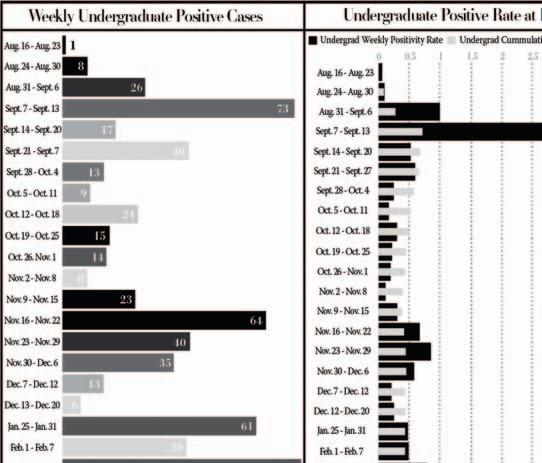
The Instagram account has since been popping up on the screens of many Boston College students’ feeds, and Jessani said in an interview with The Heights that he has dedicated the last year of his life to providing news based on facts and reality.
TUT ’s purpose is to cover what you aren’t seeing on the front page of newspapers and on CNN or FOX,” Jessani said. “Through platforms such as Instagram, TikTok, and our own website, we try our best to cover the topics that aren’t being discussed enough, but we deem necessary for the public to know.”
The outlet covers topics ranging from the farmers’ protest in India, to the Uyghur Muslim concentration camps in China, to the case for D.C. statehood.
Bryant’s death was the spark, Jessani’s frustration with the age of disinformation was a factor, but Netflix’s cancellation of Patriot Act with Hasan Minhaj made it personal, he said.
As a member of the South Asian community, Jessani said that the show’s cancellation was the final factor in his decision.
“I had the motivation to start this,” Jessani said. “I had the motivation to do something beyond myself. I had the problem. Then getting it into the real world was all I had left to do, and from this, The Unfortunate Truth was born.”
TUT is different from some other media outlets seen on Twitter and Instagram feeds, Jessani said, due to its fact-checking process.
“Everything is fact-checked by academia, professors, and not checked by other media outlets …,” Jessani said. “We as college students have direct access to the smartest minds in their fields … We have resources right in front of us. Thus 100 percent of our content is consulted by professionals in the academic field.”
Jessani said that he bases his choices of what media to cover on asking the right questions, not proving already-established facts.
“For example, I will never put out an episode attempting to prove climate change,” Jessani said. “We must face the facts, and climate change’s existence has already been proven
fact. My team and I are not going to waste our time on that. However, i f you want TUT to cover how climate change is affecting a certain sector of the human population, that is something we would be interested in factually covering.”
Jessani said that he has a team of eight other full-time college students working for him, one of them being his best friend and TUT ’s Chief of Staff Kris Iacobelli, a sophomore at the University of Central Florida (UCF).
“I believed in Rahim, and I kne w he had the potential to make this a big thing, so I joined him in June,” Iacobelli said. “We call each other every day at noon, hop onto Canva, and generate that day’s post.”
As a native Floridian himself, most of Jessani’s team is based at UCF, but Jessani hopes to begin opening chapters at schools like the University of Massachusetts Amherst and the University of Miami.
“If you genuinely want to make a difference, join my team,” Jessani said. “This is a ground-up movement. We can all make a difference and change each others’ lives, it just takes stepping up to the plate and finding those little moments that make what you’re doing worth it. It’s hard to grasp at first, but it takes work to make this world better, it’s not gonna just become better on its own, and that is the real unfortunate truth.”
THE HEIGHTS A3 MONDAY, MARCH 1, 2021
B Y J ULIA L ANDWEHR Heights Staff
Have You Herrd?: BC Grads Launch Social Media App
Gaillardetz, from A1
a move meant th e foun d ers hate f u l v er l s connected to em th in k twice a re p rou d o f especia l ly in t h e e r a o f CO VI D- 19 and are asking for n ew features to be added to the sa id th e y use s a m pa b u to J stu fo r ’22 M athie u what’s happeni th at h e pr ovi d t hat students
ÉAMON LAUGHLIN / HEIGHTS EDITOR
CHARBONNEAU / HEIGHTS EDITOR
OLIVIA
By Karolina Bertulis Heights Staff
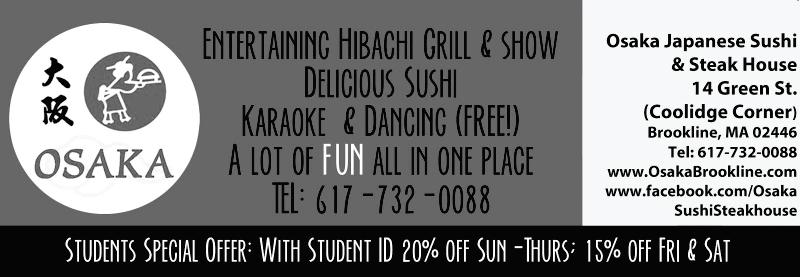
With a new year comes some new habits, right? If you are looking to reduce your environmental footprint while bringing a new look to your year, sustainable fashion is for you. Making an effort to shop sustainably will not only mix up your wardrobe, but will also save you some cash, along with cutting down on material waste, water usage, and general pollution.
Shop For New Clothing From Sustainable Brands

If you are someone who prefers to purchase clothing “new,” there are several clothing brands and manufacturers that are centered around their sustainability efforts such as Everlane, Reformation (who has a store on Newbury St.), and MATE the Label.
If you prefer to stick to the brands you know, however, there are several
well-known brands who are committed to being more environmentally conscious such as Levi’s, the H&M Conscious collection, Patagonia, and Athleta. Madewell’s Blue Jeans Go Green program gives a $20 discount on new jeans if you donate an old pair, which will be used to insulate housing in communities in need.
Lastly, a third popular option that falls under this category is purchasing from Rent the Runway, which allows you to rent clothing for a period of time. Therefore, instead of having many people buy the same item that will only be worn once or twice, many people can wear a singular item and prolong its life cycle.












Purchase Second-Hand Clothing
Hop on one of the most popular and environmentally friendly fashion movements and begin purchasing your clothing second hand! There are several thrift stores in Boston that you can visit such as Goodwill in the Allston-Brighton area,
Boomerangs, Buffalo Exchange, Vivant Vintage, Covet, and The Garment District.
If you prefer to do your shopping online due to COVID-19, popular apps such as Depop and Poshmark allow people to sell high-quality clothing and accessories in good condition. Additionally, there are several popular companies that “upcycle” and restore clothing such as the Urban Renewal line at Urban Outfitters, the Upcycled collection at RE/DONE, ASOS Reclaimed Vintage, Patagonia’s Worn Wear ReCrafted collection, and The Vintage Twin.
Lastly, a simple yet fun option to consider is swapping clothing and accessories with your roommates and friends.
Sell or Donate Your Clothing
On the flip side of purchasing second-hand clothing, you can contribute to sustainable fashion by selling or donating
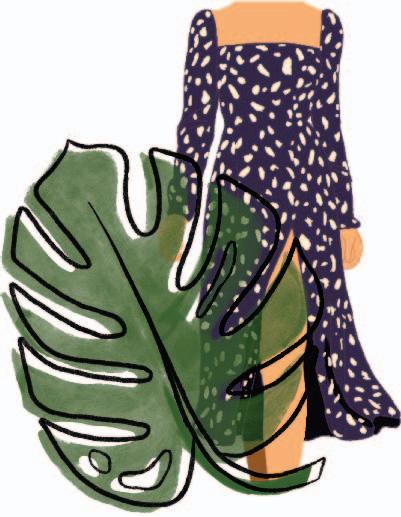
the clothing and accessories you do not wear anymore. One way to go about this is by using apps such as Letgo, Depop, and Poshmark, which automatically removes shipping costs and generates a shipping label for all packages. If you prefer to donate your clothes, Goodwill and The Salvation Army are two companies that have countless locations nationwide to do so. Two other options geared toward “fancier” brandname clothing include Plato’s Closet and Thredup. Plato’s Closet, which has a location in Waltham, Mass., is a company where you can make an appointment to bring in clothing, the employees sort through it, and then pay for whichever clothing they want to take. This location, however, is temporarily not purchasing items due to the
pandemic. Thredup is a service that provides a premade label for you to ship out your items to them and then get paid for whichever products sell online.
Alter Clothing You Already Have
Lastly, a creative approach to becoming more sustainable is altering the clothing you already have! This trend has been capitalized upon by several companies such as SOJARA, who alter and rework vintage clothing. But, if you have your own clothing that you would like to rework, there are several routes to go about it. Some options include distressing denim, cropping hoodies, altering the necklines of shirts, and painting and embroidering clothing.
Nursing Alumna Participates in Pfizer Vaccine Trial
By Celia Mathay Heights Staff
When she graduated from Boston College’s Connell School of Nursing in the 1980s, Nancy Mignosa never could have imagined the impact that COVID-19 would have on the medical world. She also could not have predicted the crucial role she would come to play in the fight against the pandemic by volunteering to be a subj ect in Pfizer’s vaccine clinical trials. But given Mignosa’s history working as a clinical research coordinator for almost 20 years, participating in the Pfizer trial just made sense.
“As soon as there was talk of coronavirus vaccine development, I knew that was something I would be interested in,” Mignosa, BC ’86, said.
Mignosa knew from a young age that she wanted to become a nurse. In high school, Mignosa was a candy striper—an antiquated term for a hospital volunteer, she said—which pushed her toward a path in nursing.
Mignosa began her nursing studies on the Heights in the summer of 1982, w here she made fond memories with her nursing friends at BC—the program was a very cohesive group, she said. She remains friends with many of her nursing classmates to this day, and the professors she had made lasting impressions on her.
To pay it forward for the professors who helped her along the way, Mignosa now precepts BC nurse practitioner students like Kaley Grammatico, CSON ’20.
“Nancy was the greatest preceptor that I could’ve asked for,” Grammatico said. “She truly was so knowledgeable about all things pediatrics, and the fact that she was a BC graduate was really helpful. I could’ve never done it without her.”
After seven years at Boston Children’s Hospital, both on the medical surgical floor and in the neonatal ICU, Mignosa became a nurse practitioner. In 1993 Mignosa became a double Eagle when she returned to the Heights and received her master’s of science in nursing.
Soon after, she began working at Woburn and North Andover Pediatrics Associates in Woburn, Mass., where she still works today.
Woburn and North Andover Pediatrics Associates, a large pediatric office with 20,000 patients, hosts clinical research in collaboration with big pharmaceutical companies to complete vaccine clinical trials. Mignosa got involved early in Woburn’s introduction to clinical research, where she worked for 17 years.
Mignosa said she learned a lot about vaccine and drug development during her time as clinical research coordinator, which fostered her faith in scientific advancement. This trust in the rigor of clinical trials led Mignosa to volunteer in several vaccine clinical trials over the years. She even enrolled her children in the meningitis vaccine clinical trials, she said.
With the onset of COVID-19 last spring, Mignosa’s interest in vaccine clinical trials became all the more relevant.
In what became a competitive search among health care workers, Mignosa began hunting for COVID-19 vaccine clinical trials, investigating both Pfizer and Moderna.
From early on in the pandemic, Mignosa had been reading deeply about vaccine development, she said, seeing it as a way to combat COVID-19.
Mignosa ended up getting into a Pfizer study in Warwick, R.I. through Velocity Clinical Research, although she would have gladly enrolled in either study, she said.
Mignosa’s husband and son also enrolled in the Pfizer vaccine clinical trials, she said. Her daughter, Kate Mignosa, CSON ’19, enrolled in the Moderna vaccine clinical trials.
“Our family had a competition— we were team Pfizer versus team Moderna,” Mignosa said. “It was all very lighthearted, but we were racing to see which vaccine would receive FDA approval first.”
Mignosa received one dose of the trial vaccine in August and the other in September. Before each shot, volun-
teers had bloodwork done and agreed to a nasal swab. Mignosa completed a weekly online diary, answering questions about how she was feeling.
“I was really excited,” Mignosa said. “That first day was crazy, when I came out with my shot. I sent pictures to my whole family with my Band-Aid. It was historic, and it was life-changing.”
Following her initial appointment, Mignosa had to complete an electronic diary once a week, noting any COVID-19 symptoms.
Those participants who experienced symptoms had to perform an at-home nasal swab COVID-19 test and send it in for testing, which Mignosa did once, she said.

Three weeks after the initial dose, Mignosa received her second trial vaccine after more bloodwork and a nasal swab. She returned a month later for additional bloodwork and another nasal swab, she said.
There’s a catch to these vaccine clinical trials—half of the participants always receive a placebo, and Mignosa was one of them.
In December, when the FDA authorized the Pfizer vaccine for emergency use, Pfizer unblinded healthcare professionals who participated in the trial, Mignosa said.
In mid-December, Mignosa found out that she received the placebo vaccine.
Though she wasn’t very surprised to have received the placebo, she said, Mignosa couldn’t help but marvel at her bad luck. Luckily, her participation in the trial meant that she was able to receive the actual vaccine soon after.

“I was like, ‘Of course I got the placebo,’” Mignosa said. “Fortunately, I was able to go back to the study site a few days later, and had my first vaccine on Dec. 21.”
Study participants are followed very closely after trials, Mignosa said. If Pfizer had not unblinded placebo participants, they would have had to return to the study site for bloodwork and a nasal swab every six months for the next two years, Mignosa said.
Receiving the vaccine has instilled
a sense of hope in Mignosa.
“It’s been unbelievable,” Mignosa said. “The day I got the real vaccine was truly one of those goosebumps, teary-eyed moments.”
Mignosa has suffered no severe side effects from the Pfizer vaccine, she said.
this vaccine has been too rushed,” Mignosa said. “The amount of money and the cooperation of scientists behind this has helped us to move things along faster than any standard clinical trial.”
While Mignosa is not a vaccine expert, she said that scientists have
“After the first vaccine, my arm hurt a little bit, like I had just gotten a flu shot,” Mignosa said. “But, either way, I wasn’t worried about the side effects—I just focused on comparing the potential risks and benefits of the vaccine.”
Still, Mignosa does acknowledge the fear that some people have of the COVID-19 vaccine and its side effects, she said.
“I know that people are so worried about the side effects, and it’s true that some people do have a day of side effects,” Mignosa said. “But we just have to think of any side effects as the body’s strong immune response, showing that we are going to be protected. If we got the virus, we would likely have more than a day of some side effects.”
Due to her participation in the trial, Mignosa witnessed firsthand the credibility of the vaccine development, she said.
“I don’t support the notion that
been advancing vaccine technology for a long time, which has assisted in the efficient and better development of vaccines.
In the face of mounting academic setbacks for children, a troublesome economy, increased rates of depression and anxiety, and the overall struggle of pandemic fatigue, Mignosa believes that the vaccine will make a big difference.
“As we can get the health care professionals, elderly people, and teachers immunized, we will get closer to returning to a more social society,” Mignosa said. “I really think that the vaccine is our only answer to coming out of this pandemic.”
Mignosa recently volunteered in a vaccine clinic for a day, administering the shot to providers in her office.
“People are just ecstatic. There’s a sense of hope that I feel like we’ve been missing for almost a year,” Mignosa said. “The vaccine, to me, means hope.”
THE HEIGHTS
Nancy Mignosa took part in Pfizer’s COVID-19 vaccine trial.
Fashion 101: How To Become a Sustainable Consumer
A4 MONDAY, MARCH 1, 2021
The Salvation are wo ou ntless locat i o n s n aonwide t orandines a nd hever wantto been up on co mp a s S O al te r vintag B h a ve cloth wou w o r se v to it t ho i n g t ofshirts the not wear about as L ma r ot h fancier” ngs, Buffalo ntage, Covet, and ment District. ou o 9, apps D epop h ma rk op le to quality clothaccessoriesingood h, on material usage, tion. F or New r om Su snds e someone o purchase w,” there are ng brands actu r e r s e n te r e d s such as formation ore on Ne wd MATE the from which a clothi time. of ha th will o or twic wear a Pu ond-Ha Ho most viro n fas begi se
PHOTO COURTESY OF NANCY MIGNOSA
GRAPHICS BY MEEGAN MINAHAN / HEIGHTS EDITOR
Center for Teaching Excellence Adapts To
 By Brady Luck Heights Staff Indio Day Heights Staff
By Brady Luck Heights Staff Indio Day Heights Staff
When COVID-19 made its way to the United States, the education system was thrown for a loop. Educators nationwide scrambled to find solutions to get them through the 2020 spring semester, and then had to prepare for the uncertainty of the following academic year. Fortunately, Boston College had the Center for Teaching Excellence (CTE) to lean on. Beginning in March, the group set out to prepare not only for the immediate transition to remote learning but also for a longer-term shift in pedagogy.
Before BC moved online for the semester, the CTE’s role was to provide technical support for in-person classrooms. In March, they pivoted their resources and knowledge entirely to assist professors in the transition to online learning. The first few weeks were the most challenging, Kim Humphrey, the instructional designer for the CTE, said.
“At first it was wild,” Humphrey said. “We had 120 folks, showing up to our sessions for like an hour and a half to just ask every question they've ever had about Zoom.”
Stacy Grooters, the current executive
fairly new, although it already had a strong foundation due to the work of its predecessor, Instructional Design and eTeaching Services, she said.
“It was about a year old when I got here and so I came into a relatively new position which was the director of faculty programs,” Grooters said. “My job was to create programs and other opportunities for faculty and graduate students to come together to think about teaching and support each other in their development as educators.”
Along with the work Grooters and her team were doing to help faculty development, the CTE was also in charge of supporting educational technology, including making sure Canvas was working and all other in-class technology was fully functional. Prior to the pandemic, her team worked only with minimal forms of online education, Grooters said.
Around the time Grooters was promoted to director, the support for online education section split off and created its own department, now called the Center for Digital Innovation and Learning (CDIL).
To adapt to the sudden transition to online learning, the CTE had to quickly narrow in on two main platforms—Zoom and Canvas. While Canvas has been a part of BC learning for a while, Zoom was new
In help sessions, the center taught faculty how to incorporate Zoom and Canvas into their curricula. During the first few weeks, it became clear that the center needed to be flexible, Grooters said.
“We had to be able to tailor our services for people at very different levels of comfort when it comes to technology,” Grooters said. “For example some [professors] need an entire workshop on how to use Canvas functions such as the gradebook while some people just need a few little tweaks, because they’re pretty comfortable and just want to learn how to use an advanced setting to make their lives a bit easier.”
In addition to helping professors gain proficiency and comfort with these platforms, the center provided feedback for faculty on their specific ideas of how they wanted to teach remotely.
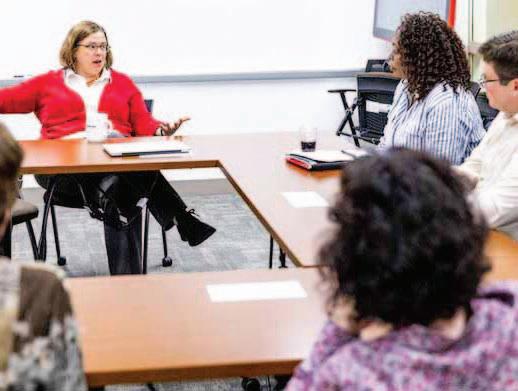
“A lot of what any faculty member is trying to figure out is particular to their own teaching and their own way of using the technology,” Castricum said. “That’s why it’s so important to us to provide chances to hear their questions and help professors work through specifically what they need to learn in order to teach effectively.”
In the past, this feedback was communicated by the CTE through programs such as a series of monthly lunches for junior faculty members, in-person oneon-one meetings with the CTE staff, and a teaching retreat held twice a year—but with the pandemic, the center had to adjust.
“We’ve been able to take many of the aspects of our programming and move them online, but we’ve also needed to make some shifts like the fact that the teaching retreat has been canceled,” Castricum said.
Despite this, the CTE has looked for silver linings, Castricum said.
“We can’t do [the retreat] because it’s way too logistically challenging, but on the other hand, that frees up time to do some things that we need to focus on much more such as technological support for teachers,” Castricum said.
One of the CTE’s biggest challenges was the fact that there was minimal precedent for what it would mean to teach a synchronous Zoom course, Grooters said.
Before COVID-19, she managed five graduate assistants, but after receiving extra funding last spring, she was able to hire more.
While they were still on campus last spring, these graduate assistants were on around-the-clock calls, taking care of any questions about Canvas or Zoom as professors struggled to adapt, Minnone said. They were also in charge of co-facilitating the initial online workshops for faculty that allowed for a smoother transition into the following school year.
With the entire BC community adapting to the new normal together, the CTE’s ability to implement the most efficient use of technology eased the difficulties professors faced when their concept of teaching and learning changed drastically.
“When it started it was really about getting folks up to date and then just the basics of how to use the technology,” Humphrey said. “Now it is really trying to think about teaching right rather than the technology we’re going to use to get that done. A lot of it is shifting to be slightly more philosophical conversations about what it means to do the central work of teaching.”
For the spring semester, the systems that the CTE put into place will look the same, with some small changes based on the responses and feedback they have received from faculty.
“The work that we do is a combination of sort of looking ahead and anticipating what faculty are going to need while at the same time being responsive to what we are hearing,” Castricum said.
To help incorporate feedback from professors into future plans for the CTE, the center set up a series of roundtable discussions to hear feedback from professors about how the spring semester last year went. These sections ran from October to December and will continue into the spring semester.
Each roundtable focuses on a different topic—there was a pre-election teaching check-in in late October. Other topics have been “Exploring Anti-Racist Pedagogies” and “Learning Together in Community,” and their most recent roundtable, which took place on Jan. 21, aimed to help professors run lab sciences during the pandemic.
director of the CTE, also said that the unprecedented month created a heightened demand the CTE was not used to.
“In the past, we probably would have said ‘Hey, let’s just sit down together for an hour and we’ll walk you through this,’ but with such a large-scale demand this year, we had to get creative pretty early in the process,” she said.
Grooters has spent six years at the center and two as director, but this year's unforeseen challenges changed her role drastically, she said.
When she was hired, the CTE was
to the majority of professors.
Sarah Castricum, the assistant director of faculty programs at the center, noted the challenge of helping professors who are used to classroom-based learning adjust to the new technology-based environment.
“As a result, there are many faculty who do things like smaller seminars where it’s all about the discussion, and technology is maybe not going to have such a natural fit there … so there’s a kind of particular work to do in that space with the enforcement of using technology,” Castricum said.
“There was really very little out there we could turn to and say ‘Oh, here’s this pedagogy that’s already been developed and tested and people know how to do it,’” Grooters said. “We spent this summer basically inventing new ways of teaching that work in an online setting.”
To alleviate the soaring demand for their services over the summer, the CTE took on more graduate student assistants, who have been crucial during these strange times, Francesca Minonne, the assistant director for graduate student programs said.
While the CTE has been instrumental in providing support to professors, the staff stresses that the ability for students to return to campus and resume classes was a large team effort.
“You can’t tell the story of the COVID transition period without talking about the CTE, CDIL, and ITS [Information Technology Services] ... we supported folks hand in hand,” Grooters said. “Student Services did amazing things with scheduling and making sure all of that worked, but I think in terms of supporting faculty and making sure they were ready to step into their classrooms, whether they were real or virtual, the CTE, CDIL, and ITS worked really closely to make sure that the faculty were ready for that.”
“Our goal is to have a couple of faculty members who have explored some aspect of a certain topic and come in and talk for a bit to kind of prime the pump and put some suggestions on the table, just out of the things they’ve tried to kind of open a conversation about it and other faculty are able to share their ideas as well,” Castricum said.
The CTE’s expertise can’t stand alone—engaging with and hearing from faculty members is crucial, Grooters said.
“Honestly, I don’t think there’s a lot that we’ve heard yet that surprised us,” she said. “We knew it was going to be hard … I think it’s more that I’m just really excited to hear from faculty about what solutions they’ve discovered. And that’s where we need the creativity of the faculty … to hear, ‘Oh I figured this out.’”
Museum of Fine Arts Celebrates Basquiat’s Legacy
Brathwaite), Futura (Leonard McGurr), Keith Haring, Kool Koor (Charles Hargrove), LA2 (Angel Ortiz), Lady Pink (Sandra Fabara), Lee Quiñones, Rammellzee, and Toxic (Torrick Ablack).
Together they fueled the rise of hiphop and street art, inspired by their Black, Latinx, Caribbean, immigrant, and cosmopolitan experiences, according to a plaque displayed at the exhibit.

The exhibit showcases the multifaceted span of the artistic media and techniques employed, ranging from painting, sculpture, and fashion to music and film.

“It’s interesting that the work displayed was by a community of artists,” Helene McNabb, a high school student from New Hampshire, said. “Many of them were friends and collaborated together to make meaningful art.”
Moon King” (1984), as “chromatic, dynamic, and busy.”
“You come here, and you see something like [Basquiat’s “Famous Moon King”], and you see how bold he was, the risks he took, and how super creative he was,” Calabrese said. “To make something of such a scale, you have to be fearless.”
The exhibit signals at and explores the themes of criminal justice and racial discrimination. One of the featured works, “Flashlight Text Survival” (1983-1984) by A-One and Jenny Holzer, alludes to police brutality and perseverance. The phrase “when someone beats you with a flashlight, you make light shine in all directions” is in the center of the painting in black, bold capital letters, and a man of color’s solemn
expression is also portrayed in the midst of spontaneous, colorful streaks of spray paint on the canvas.
“I didn’t hear too much about police brutality in the 1980s,” McNabb said. “Modern events brought it to the forefront of the media, so it is interesting to see how social injustice has been a constant theme in art.”
The exhibit captures the bold art of the emergent hip-hop movement, which Basquiat and his peers helped to pioneer. Writing the Future: Basquiat and the HipHop Generation will be on display at the MFA Boston through May 16 at the Ann and Graham Gund Gallery.
“It is a high time to have more exhibits of this nature,” Cheney said.
By Elinor Ketelhohn Heights Staff
In the post-graffiti movement, pioneered by Jean-Michel Basquiat in 1980s New York City, street art evolved to become recognized in the fine arts world. Basquiat catalyzed a global revolution in art, music, and design, becoming a front-runner in contemporary American art, according to the Museum of Fine Arts (MFA), Boston website. His legacy is celebrated in Writing the Future: Basquiat and the Hip-Hop Generation at the MFA.
Prior to the MFA’s reopening in February, the exhibit was originally available virtually through the MFA mobile app, free of charge in October 2020. According
to the app, the virtual experience only included information about the art without showing specific pieces or playing clips from the exhibit.
While the app focused on informing the viewer, the virtual exhibit lacked the immersive experience of the physical exhibit.
Within the exhibit, works by Basquiat and other artists from the “hip-hop generation” are categorized according to the themes explored in the art rather than by the artist. Sections of the exhibit include Writing the Future, Post-Graffiti, Portraiture, Writers, Big Screens, Music, Futurisms, Bodies, and Ascension.
The exhibit features numerous artists, including A-One (Anthony Clark), ERO (Dominique Philbert), Fab 5 Freddy (Fred
To curate this technique-rich exhibit featuring various media, co-curators Liz Munsell, Lorraine Bressler, and Alan Bressler worked with musician and writer Greg Tate alongside biographer Dakota DeVos, according to the MFA’s website.
Basquiat’s mixed-media paintings, often incorporating a combination of acrylic, oil stick, and pencil on canvas, are the focal points of the exhibit. He is best known as a neo-expressionist and a trailblazer of the post-graffiti movement, embodying the spirit of emerging art in 1980s NYC, according to the MFA website.
“Basquiat’s art is simply beautiful to look at,” Rebecca Cheney, an attendee from Harvard, Mass., said. “His pieces have a wealth of creativity.”
Jack Calabrese, another museumgoer and Winthrop, Mass. native, described the gallery’s last painting, Basquiat’s “Famous
THE HEIGHTS
Pandemic
A5 MONDAY, MARCH 1 , 2021
PHOTO COURTESY OF STACY GROOTERS
PHOTO COURTESY OF STACY GROOTERS
Pre-COVID-19, the CTE hosted its Excellence in Teaching program in person.
MOLLY BANKERT / FOR THE HEIGHTS
Seem To Be A Grief Provision.”
Grooters led a workshop in collaboration with the School of Social Work.
Lady Pink and Jenny
Holzer
collaborated on “Tear Ducts
ELINOR KETELHOHN / HEIGHTS STAFF
ERO’s “Beyond Fresh” (1984) features large architecture and engravings.
‘The Heights’ Endorses Jack Bracher and Gianna Russi for UGBC President and Vice President
The Heights endorses candidates Jack Bracher and Gianna Russi, both MCAS ’22, for the 2021 Undergraduate Government of Boston College president and vice president.

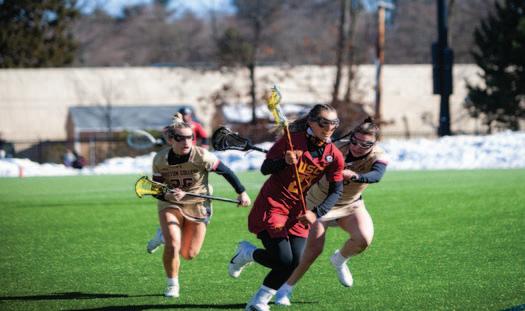
This endorsement is based on each team’s policy platforms and the 30-minute meetings that The Heights editorial board held with each team. Out of the four teams running, Bracher and Russi are the best equipped to effectively lead UGBC and bring policy proposals to the University administration.


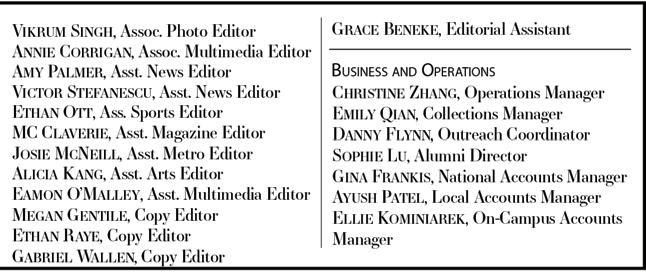

After meeting with each of the teams, it is clear that Bracher and Russi have the best team dynamic. Neither of them dominated the conversation, they seem to have a common understanding of their campaign priorities, and their respect for one another is obvious.
The Heights’ conversation with Bracher and Russi was very productive. Compared to the meetings with the other teams, it was Bracher and Russi’s collaborative approach that really set them apart. Both of them had thorough and genuine responses to questions posed by the editorial board. While some of the other teams’ answers were vague and primarily delivered by the presidential candidate, Bracher and Russi both equally contributed direct answers.

Both Bracher and Russi have experience in UGBC, so they know how the organization works, and where it has failed and succeeded recently. Several of the other candidates also have experience in UGBC, but Bracher and Russi’s approach—balancing a realistic understanding and optimistic vision for the organization—is especially compelling.
Week in Photos
Their policy platform is comprehensive, with 15 detailed policy areas. Unlike some of the other campaign teams, they focus on goals that they can actually accomplish—or at least establish a foundation for—in the span of a year. While other campaigns have similarly comprehensive and intersectional policy platforms, it is Bracher and Russi’s realism that sets them apart.
They take a pragmatic approach to their environment and sustainability policy. In addition to continuing to ask the University to divest from fossil fuels, the duo plans to create an environmental and sustainability division within UGBC to further work toward the goal of divestment. Bracher and Russi are also aware that UGBC is not the only student organization on campus doing important work, so they plan to collaborate with student groups, including Climate Justice at BC and EcoPledge, in the process of creating the division. Bracher and Russi’s willingness to delegate work shows that they are strong leaders.
One of the UGBC reforms that Bracher and Russi have planned is the promotion of the chairs of the AHANA+ Leadership Council, GLBTQ+ Leadership Council, and the Council for Students with Disabilities to director positions on the Executive Council. This reform will elevate the voices of students within those communities by giving their representatives more decision-making power. It would also raise the value of the stipends that those representatives receive, which as Bracher and Russi acknowledge, encourages diversity in those roles. UGBC is an enormous time commitment, and comes at the expense of a work-study job for students
who need it. Bracher and Russi stressed that they would take their stipends and encourage others to do so as well, so as to avoid creating an environment in which someone feels embarrassed to take a stipend that they depend on to fully commit to their job in UGBC.
Bracher and Russi also have realistic policies regarding the creation of an accessible path to Upper Campus and the establishment of an LGBTQ+ resource center in a currently unused space in Carney Hall. They also acknowledge that these two issues have become campaign buzzwords in recent years, with teams campaigning on these promises and not bringing them to fruition. It was refreshing to hear this sentiment from a campaign team.
UGBC already passed a non-binding resolution to create an accessible path to Upper Campus in September, but the University has not acted on it. The administration has also shut down previous talks of an LGBTQ+ resource center. So, possibly the most important quality in candidates for UGBC president and vice president is their ability to form an effective relationship with the University administration. The Student Assembly can pass resolutions, but it is up to executive leadership to make them actually happen. Bracher and Russi are the duo best positioned to use their respective offices to change BC for the better.
Based on their comprehensive policy platform, their prior experience, and their dynamic as a team, The Heights is confident that Bracher and Russi are the best suited candidates for the job.
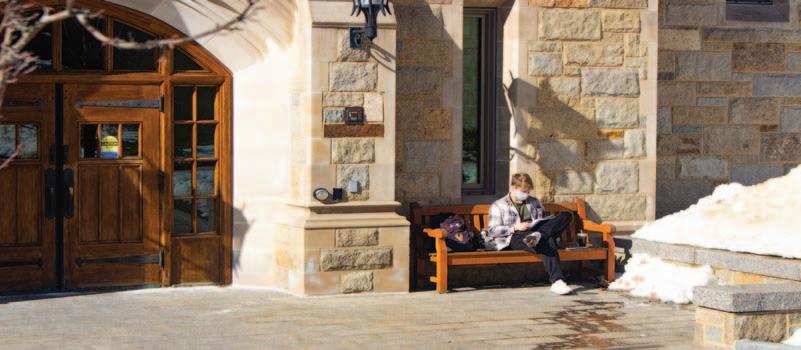
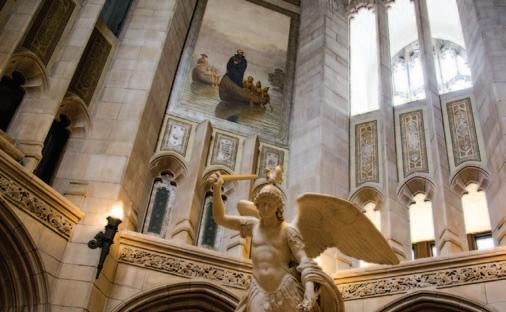
THE HEIGHTS A6 MONDAY, MARCH 1, 2021 EDITORIAL
Top photos, left to right: A student studying on the second floor of O’Neill Library, Wednesday, Feb. 24, 2021; BC women’s lacrosse celebrates after scoring a goal against USC, Saturday, Feb. 27, 2021; A student studies on a bench outside of Stokes North, Wednesday, Feb. 24, 2021.
Bottom photos, left to right: The statue of Saint Michael inside Gasson Hall, Tuesday, Feb. 23, 2021; Students study and attend virtual class on the Stokes bridge, Tuesday, Feb. 23, 2021; USC sophomore defender Danielle Carson attempts to evade BC senior attacker Charlotte North and graduate attacker Cara Urbank, Saturday, Feb. 27, 2021.
(STEPHEN MOONEY / FOR THE HEIGHTS); (MOLLY BANKERT / HEIGHTS STAFF); (NICOLE VAGRA / FOR THE HEIGHTS).
Race To Replace Speaker DeLeo Is an Opportunity: Bring About Change or Entrench the Boys’ Club
endorsed by big names including former U.S. Representative Joe Kennedy III and Massachusetts Attorney General Maura Healey, but on Feb. 23, Kennedy and Healey formally rescinded their endorsements of Capobianco after a series of accusations dating back to 2006 surfaced.
SOPHIE CARTER
Immediately after Robert DeLeo, the longest-serving speaker of the Massachusetts House of Representatives, announced on Dec. 28 of last year that he was planning to resign, a number of candidates jumped at the unique opportunity to fill the seat for Revere and Winthrop.

Only two of the four Democrats on the ballot for the March 2 primary of the special election—Valentino Capobianco and Juan Jaramillo—have received endorsements from national political figures. These endorsements, coupled with the candidates’ personal politics and histories, illuminate exactly how much of an opportunity this election is: either bring material change to the State House or further entrench the misogynistic boys’ club that has long existed there.
Capobianco, a former member of the Winthrop School Committee, shows decidedly little interest in progressive policy and is more lukewarm than his competitors when it comes to prioritizing the working-class communities of Revere and Winthrop. If elected, he would ensure the persistence of the boys’ club in the House, which routinely upholds the interests of the wealthy, white, and male elite in Massachusetts state politics. Capobianco’s Revere Journal op-ed explaining his motivations for running is chock-full of meaningless platitudes and devoid of concrete policy proposals. He instead opted to spend the majority of the piece discussing vague niceties such as his commitment to the values of “honesty,” “service,” “listening,” and “opportunity.”
Lack of policy prowess aside, fitness for the job is a far more important question in this local race. Capobianco has a history of misogynistic and disrespectful remarks on his personal Twitter account, as well as a slew of allegations of sexual misconduct. Capobianco was
According to GBH News, these incidents involving Capobianco have included “aggressively pursuing younger women, attempting sexual acts with non-consenting inebriated women, repeatedly asking to perform sexual acts in exchange for money after being told to stop, and unwanted and repeated sexual advances.” In one of the detailed incidents, Capobianco followed a young woman home after a party, prompting her to hide in a bush and call her mother for help.
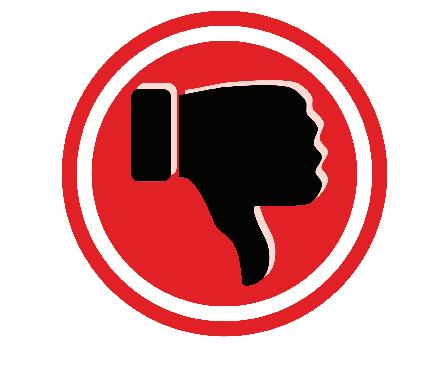
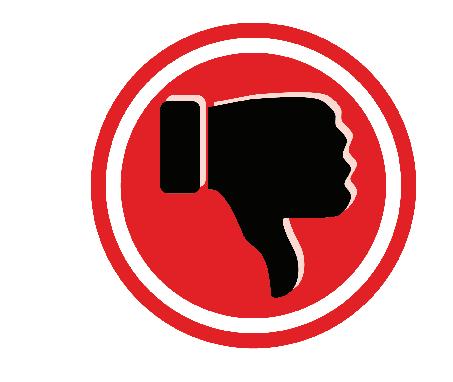
Capobianco claims that these allegations are false and politically motivated. News of Capobianco’s disrespect for women and nonchalant attitude toward sexual misconduct does not come completely out of left field, however. Immediately after he announced his candidacy, Twitter users compiled a series of tweets by Capobianco in which he admitted to harassing female strangers and objectified female celebrities, commenting on their appearances. He also advocated his desire to have an “Italian Heritage Day” in addition to Indigenous Peoples’ Day and refers to undocumented immigrants as “illegals.” The warning signs of Capobianco’s poor judgment and skewed worldview have been there since the beginning— his endorsers just didn’t look close enough.
Jaramillo, on the other hand, can be described as a progressive with an extensive history of doing hard work in the Revere community. In sharp contrast to Capobianco, Jaramillo could be a force for progressive change.
Jaramillo grew up in a working-class background as the son of immigrants escaping violence in Colombia, and his experience in the political realm has been oriented toward empowering and assisting his community.
When he served as budget director for State Senator Joe Boncore, Jaramillo prioritized access to housing, public transportation, and health care. Jaramillo recognizes the urgency of tackling climate change to protect his coastal community, the impact of good after-school programs for public school students, and the necessity of criminal
justice reform. In his current position as the political coordinator for the local branch of the Service Employees International Union, he demonstrates solidarity with working people and a willingness to put in the work in his community, especially with regard to advocating for frontline workers who have been hit hardest by COVID-19. Revere is one of the top five towns in Massachusetts that has been hardest hit by the virus, and the community deserves a representative who has demonstrated resolve to tackle both the virus and the social inequalities that it has exposed.
Based on Jaramillo’s track record and progressive policy bent, it comes as no surprise that he has received endorsements from Vermont Senator and former presidential candidate Bernie Sanders and U.S. Representative Ayanna Pressley. These key endorsements from progressive national figures such as Sanders and Pressley speak volumes about Jaramillo’s outstanding dedication to fighting for the working class and delivering for his community. His progressive voice is a much needed addition to the more moderate and restrained boys’ club on Beacon Hill.
A comparative look at the candidates reveals that this special election presents a unique opportunity. While Jaramillo has a high-profile endorsement from Sanders, Capobianco has secured dozens of endorsements from elected officials and labor unions, and also has $25,000 more in his war chest than his opponent. It remains to be seen what will come of the allegations against Capobianco, but one thing is exceedingly clear: if the people of Winthrop and Revere choose to elect Jaramillo, they can expect to gain a competent policy wonk and fierce advocate for the community at the State House. But, if Capobianco comes out on top on March 2, his election will signal a continuation of the same insulated, unaccountable, and disappointing nature of the Massachusetts State House that has persisted for decades.
Sophie Carter is an op-ed columnist for The Heights. She can be reached at sophia.carter@ bc.edu.

This week, the Boston winter has gone on spring break, and it’s been great. The warm weather has melted away most of the snow and the winter blues. Even if it was just for this week, being able to go for a run, eat lunch outside with friends, or not wear three layers, has been a welcome change of pace.
The Museum of Fine Arts, Boston is always a thumbs up, but currently there are some exhibitions that are must-sees. Writing the Future: Basquiat and the Hip-Hop Generation is on view until May 16, and Monet and Boston: Lasting Impression is on view until March 27. You can register for both exhibitions online.

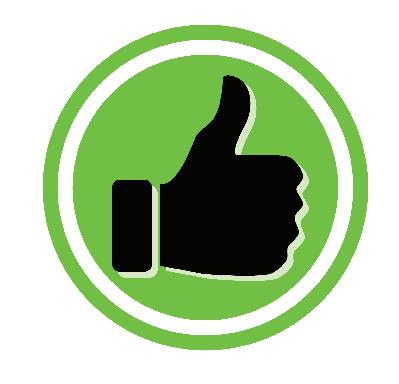
Eel Sex and Other Unanswered Questions
despite all of the innovations in science—we’ve done surgery on a grape, landed on the moon, and figured out that Viagra cures jet lag in hamsters—we still don’t know how eels have babies.
GRACE CHRISTENSON
No one knows how eels have sex.
Actually, let me be a little more specific. No one knows how European eels (also known as Anguilla anguilla) have sex.
I don’t remember where or when I first learned about this—probably from some pretentious podcast or something—but I think about it semi-frequently. I’m bored riding the Comm. Ave bus? Eel problem. I’m spacing out in class? Eel problem. Searching for an icebreaker? Eel— and I cannot stress this enough—problem.
I’m far from the first person to absolutely lose my mind about this. And let me be the first to say that I’m not making any meaningful contributions—most of my contemplations consist of me having the thought “Okay, but how do we not know?” over and over again until I get tired.
My mental efforts grow even more laughable when contextualized in the pool of people who have contemplated this before me. Some of the greatest thinkers of all time—from Sigmund Freud to Aristotle—have tried their hands (unsuccessfully) at the eel problem. The German biologist Max Schultze even grappled with it on his deathbed, lamenting that “all the important questions … had now been settled … except the eel question.”
It’s been 147 years since Schultze’s death, and

I’ve never looked at or inside a European eel (or any eel for that matter), but apparently if you do you won’t see ovaries, testicles, eggs, or milt. Aristotle’s bold solution was that eels just appear from mud (This is now number one on my list of reasons why Aristotle is the greatest philosopher of all time).
Eventually scientists figured out that an eel’s reproductive organs only develop in the last phase of a five-part metamorphosis: larvae, miniscule glass eels, elvers, older yellow eels, and, finally, adult silver eels. Thinkers like Aristotle had understandably assumed these were all different animals, rather than phases of one being’s life cycle. Now we know that during the silver stage, the eel’s stomach dissolves before their reproductive organs develop, meaning that eels die soon after reproducing (and making figuring out this whole thing that much harder).
To this day, though, no scientist has observed an eel mate in the wild or found an eel egg. The closest we’ve gotten is finding some larvae. And we still have no idea how fertilization happens. Some scientists think it happens externally, with a sperm cloud fertilizing free-floating eggs, but others disagree. The eel problem remains.
In college, we mostly focus on solvable problems. We balance chemistry equations and bubble in scantrons asking us to recall historical events. Even in philosophy classes, we have to prove we’ve memorized the theories of Plato’s Republic and Hobbes’ Leviathan. In a lot of ways, this makes sense. Professors can and should measure what we’ve learned and how well, even as we are taught strategies of thinking and theorizing
and experimenting.
But, at least for me, the proliferation of solution-oriented questions can create a false sense that not knowing something is unequivocally bad. Not having an answer, more than just being embarrassing, feels potentially injurious. It can hurt your class grade, which can hurt your GPA, which—if you let yourself thought-spiral long enough—can translate to diminished chances at having the post-grad life you’ve been hoping for.
Unsolvable and yet-to-be-solved problems— like, in this fairly ridiculous instance, eel sex— offer an important reminder that sometimes not knowing is not only okay, but inevitable.

Contemporary scientists studying the eel problem have picked up a torch carried by thousands of people. The same is true for those who contemplate if God is real, where all the antimatter went, the meaning of life, the best form of government—the list goes on. Persistent problems and the solutions that evade us are woven into the very fabric of the human experience.
Not knowing is part of who we are.
Think about THAT the next time you tank a reading quiz. Just kidding. Kind of.
Seriously, though, it’s a beautiful reminder of our humanity that, in a world where we’ve split the atom, edited genomes, and bred weird tiny dogs that look like they’re one light pat away from collapsing, eel sex eludes us.
I hope it always does.
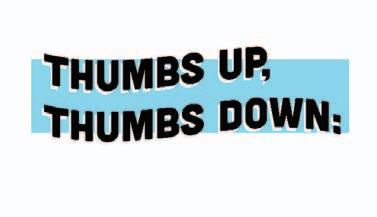
(But also, if anyone finally figures out how these eels are doing it PLEASE let me know. I’m dying for answers.)
Grace Christenson is an op-ed columnist for The Heights. She can be reached at grace. christenson@bc.edu.



The opinions and commentaries of the op-ed columnists appearing on this page represent the views of the authors of those particular pieces, and not necessarily the views of The Heights
While the mid-week break might be a bit of a breather, we could use more than just one day. This awkward “break” is really just a pit stop during the week that is going to end up being just another day of studying. BC’s motivation to keep students from traveling is understandable, but students calling this a “mental health day” is a bit of a stretch.
Midterm
Speaking of needing a break, midterm season is right around the corner and is creeping up quickly on all of our calendars. All the reading you’ve been putting off because “it’s not technically due” is knocking. Even though it might feel like we just got back from break, it’s actually time to start cramming.
THE HEIGHTS
MONDAY, MARCH 1, 2021 A7
Nice Weather
The MFA
“Spring Mid-Week Break”
Season
GRAPHIC BY MEEGAN MINAHAN AND OLIVIA CHARBONNEAU / HEIGHTS EDITORS
By Emily Kraus Heights Staff
The demand for food in Newton has risen with the onset of the pandemic and the Newton Food Pantry has risen to the occasion. While undergoing changes to its operations in order to adapt to the challenges of the pandemic, the pantry continues to support the community and implement new initiatives like the Newton Community Freedge Collaborative.
“Our client numbers served has almost tripled since the pandemic, and where we used to serve 90 households, we are now serving close to 250 households on a distribution day,” Regina Wu, president of the Newton Food Pantry Board, said.
With a growing demand for food during the pandemic, the Newton community has continued to support the food pantry with generous donations, Wu said. In order to keep up with the increased demand, and because some older volunteers had to step away due to the risks that COVID-19 poses for their age group, the
food pantry recruited more volunteers.
“We needed people who could lift 30 -lb-bags repetitively, [while] being outdoors in all different temperatures … so we basically rebuilt our volunteer base,” Wu said. “There were some of our existing volunteers that were able to stay on, but we brought on another 130 volunteers.”
Food pantry volunteers began distributing food to clients via curbside pickup outside the War Memorial Circle at Newton City Hall, giving out prepackaged bags of food including pasta and rice to comply with COVID-19 restrictions. Volunteers also drive and drop off food directly to some clients, including elderly or disabled residents.
“One of the reasons that I reached out to the pantry to see if they needed volunteers was because I wanted to make a difference and help others in the community who I know will be negatively impacted because of COVID,” Sindy Wayne, volunteer coordinator for the freedge project, said.
One of the pandemic-era initiatives the pantry started is the freedge—a public neighborhood fridge stored in a shed in a common area, Wu said. The freedge provides a way for local residents to donate what they can directly to the freedge and for people to take perishable goods they need. Perishable and non-perishable items will be available to anyone at the freedge at all times and in all weather conditions, according to the pantry’s Ernst Bertone Oehninger and Alexandra Hill originally came up with the idea of a freedge in 2012 to combat food insecurity.
Since the freedge is placed in
a public place, people can take food anonymously without fear of judgement.
“I see it as being like an additional supplemental food source to those in need in our community,” Megan Russell, a board member of Newton Food Pantry, said. “There can be a stigma around food insecurity, and going to a food pantry. Going to the freedge allows maybe a little more anonymity for people if they need food.”
The pantry first announced the Newton Community Freedge Collaborative on Feb. 14 with the motto “take what you need, leave what you can.” This freedge is part of a large network of community fridges throughout the Boston area and the country. The fridges, known for their bright colors, strive to foster community and provide accessible food for all.
“The Newton Community Freedge Collaborative is excited to launch this initiative, offering an innovative way to help reduce food insecurity and increase engagement with the Newton community,” the pantry said in a statement.
The pantry plans to donate the refrigerator, which is set to open on March 14, and will be located in parking lot space donated by the owner of Central Drapery & Dry Cleaning at 420 Watertown St., Mark Levine. Local Newton builders from Gilman, Guidelli & Below are currently donating their time and skills to tackle building a shed for the freedge.

Local businesses, including Johnny’s Luncheonette, Russo’s, Olivia’s Bistro, and Galit’s Treats Café & Bakery , will donate prepared sandwiches, meals, and soups to the freedge. Additionally, Wegman’s also has provided monetary donations. Residents are also encouraged to donate to the freedge.
The idea came to Newton after the initiative came to Russell’s attention when her friend forwarded her an article about the freedge movement in New York.
“And I took that article at that time, and I was like ‘that’s super cool, that’s a great idea. She forwarded it to me, knowing that I was heavily involved with the Newton Food Pantry, and wondering if this was an idea we could implement,” Russell said. “So I brought that article and reached out to Regina and said ‘hey you know why don’t we make this?’”
Russell brought up the idea for the Newton freedge to the food pantry board
in April, but the idea was tabled until August. Wu said that the food pantry was in crisis mode at the time and couldn’t take on a new project.
“One of our priorities was to expand our client reach, we know from looking at the data from grab and go lunches and breakfasts, and kids and families who take advantage of the school lunch program that we’re not reaching every family that uses those services,” Wu said. “So there’s a gap.”
Twelve community partners, including the Rotary Club of Newton, West Suburban YMCA, the Newton Neighbors Helping Neighbors Facebook group, and local temples and churches are involved with the freedge project. Each organization helps to provide teams of volunteers, according to Wayne.
“We’ve had many local community groups say that they want to volunteer with us or donate money, and it’s really been overwhelmingly positive so we decided ‘let’s get some different groups involved,’” Wu said.
The pantry is considering the first two weeks that the freedge is open a pilot program, when different organizations will organize separate groups of volunteers in order to help stock and clean the freedge.
“We’ve recruited team captains, a
whole variety of different organizations,” Wayne said. “Those organizations will really work closely with me to review the processes and the procedures that we put in place and refine how things are working.”
In order to keep the freedge clean and organized, the pantry is using a virtual system to schedule donation pickups.
“We have an elaborate schedule of donation pickups, and we have a QR code with a drop down for what the fridge monitor has to do when they get there in terms of cleaning. We have lists of what we’re taking and what we’re not taking,” Wu said.
Acceptable donations to the freedge include fresh fruits and vegetables, dairy products, and dry goods like flour, pasta, and rice. Other supplies, like diapers and hygiene products, can also be donated at the freedge. Donations that are not accepted include meat, seafood, opened goods, or personal leftovers.
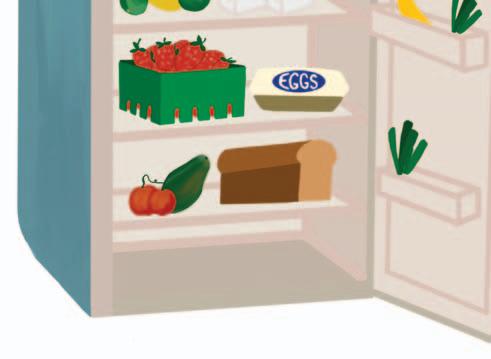
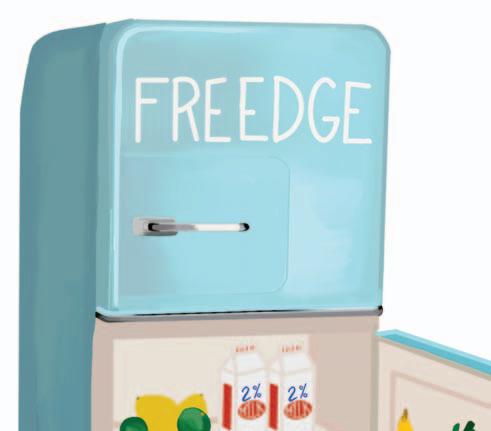
Wu said that the community has been supportive of the food pantry during the pandemic as well as the new freedge initiative.The freedge, which can be found on Instagram and Facebook.
“Every time a new initiative comes out, the more we can kind of tell people ‘Hey we’re here doing this work,’ people want to give, it’s wonderful,” Wu said.
By Julia Remick Metro Editor
A new political action committee called Save Nonantum recently formed in Newton to “preserve, protect, and promote the culture of the Nonantum community,” according to the group’s website. The group said that Nonantum, a village in Newton, is under attack by a group of politicians working to end Nonantum traditions.
Save Nonantum was established through Massachusetts’ Office of Campaign and Political Finance on Feb. 8.
Ahead of the special election on March 16, the organization has been the subject of controversy on social media, particularly in the Newton Civic Action Forum Facebook group. The special election is being held to fill two vacant at-large seats on the Newton City Council. Jake Auchincloss previously held the at-large seat in Ward 2 until he was recently elected to Congress, and Jay Ciccone, who died in November, held the at-large seat in Ward 1.
“After the passing of our beloved City Counselor Jay Ciccone it became evident that the people of Nonantum needed a voice in politics,” Francis Yerardi, chair of Save Nonantum’s Community Organizing Committee, said in an email to The Heights “With the way the city charter is written the political power elites in Newton control who is elected and oftentimes those elected officials don’t have the best interest of the people in the neighborhood at heart.”
John Oliver and Madeline Ranalli are running for the seat in Ward 1. Bryan Barash, Tarik Lucas, and David Micley are competing for the seat in Ward 2.
Save Nonantum announced its endorsement of Oliver and Lucas on Wednesday.
“We will endorse and or spend money now and in the future as it is needed to protect, preserve and promote the culture of Nonantum. We will support those in politics who support us, and stand against those who don’t,” Yerardi said in the email.
Both candidates reposted the statement on their social media accounts and said that they are grateful for Save Nonantum’s endorsement.
Kevin Riffe, treasurer of Save Nonantum, said in the statement that Oliver and Lucas are candidates who share the values of Nonantum residents, as well as residents throughout Newton.
“We are especially proud that our inaugural endorsement includes a person, Tarik Lucas, who if elected would be the first African American in 35 years to sit on the city council,” Riffe said in the statement.
“Nonantum is the most diverse community in Newton, and the time has come to have some real diversity on the council.”
Demographic reports for the City of Newton by Barry Bluestone from Northeastern University in 2014 indicate that Nonantum is the third most diverse of Newton villages, with 20.1 percent of Nonantum residents being non-white, based on census data from 2010. The most diverse villages include Newton Upper Falls with 27.8 percent non-white residents and Oak Hill Park with 22.5 percent non-white residents.
On the organization’s GoFundMe page, which received its first donations over two weeks ago, the organization describes which traditions it feels are being threatened.
“Instead of respecting our differences, they claim our traditions are offensive. They want an end to all the Italian colors and flags in our neighborhood,” the GoFundMe reads. “They have already force[d] the cancelation of celebrations of being an Italian American. If we allow them to continue they will end our festival, our procession of saints in our streets and even put an end to our Santa!”
The GoFundMe page also says that 100 percent of the funds raised will go toward preserving Nonantum’s traditions and culture, including supporting politicians who support this mission and opposing those who do not.
“For far too long our community has silently gone along, hoping you will lead us and do the right thing by us. Instead, we have been disappointed. Not by all, but by many,” a letter from Save Nonantum to the community reads. “You have disrespected our firefighters, our police, our Italian
American heritage, and the straw that broke our backs, recently it was suggested by a candidate that our community culture is not inclusive. We will not get into a who said what blame game.”
Barash and Ranalli publicly responded on social media to the issues raised by Save Nonantum.
“I don’t know where these rumors about me opposing our Italian flag paint, Festa, or beloved Santa started, but they’re absolutely false,” Ranalli wrote. “These traditions are what makes Nonantum so special to my family and have helped connect to my Italian heritage.”
Barash told The Heights that he has no desire to eliminate any Nonantum traditions and explained his personal connection to Nonantum, including the first home he bought there with his wife and his frequent bike rides in the area.
“I don’t know why anyone would be against flying the Italian flag or painting the streets green, white and red, but I will state for the record that I am for being able to continue doing those things,” Barash wrote. “I’ve been to the St. Mary of Carmen Festival many times, and in fact hope it resumes safely this summer. And as it relates to Santa, I even made a donation to the Nonantum Children’s Christmas Party Association this winter. I have the receipt if anyone is interested.”
Barash said in an interview with The Heights that he denies any claims that Save Nonantum is making about him.
“I don’t have any desire to take away people’s cultural heritage or their Italian flags,” Barash said. “I don’t have any desire to change the way that they paint the streets, or the way that they celebrate their cultural days.”
Barash said he first saw Save Nonantum on Facebook and feels that it is a smear campaign aimed against himself and Ranalli.
“The people who are leading it made it clear in their private Facebook posts that they were raising money to attack us,” Barash said in an interview with The Heights. “But they, you know, they didn’t indicate who it was against in the fund-
raiser, which I think was part of the tactic, right, to use generic allegations rather than specific names, because there’s people who donated to it who wouldn’t have a face to all the names.”
Yerardi would not name the politicians that Save Nonantum is referencing, saying that the group would not “get into a who said what blame game.”
“We have not mentioned any candidates on our website or anywhere else, the reaction by many politicians and candidates over the course of the past week have spoken volumes to us,” Yerardi said in the email.
Barash said he expects the Save Nonantum funds to be used for attack ads, although there would be no way to confirm this because the organization does not disclose its finances.
Save Nonantum received its first GoFundMe donation, raising $18,230 through 189 donations, some of which appear publicly as anonymous donations. The GoFundMe is currently disabled and not accepting new donations at this time.
Political action committes are required to document the name and the address of each political contribution, according to the Office of Campaign and Political Finance. If the donation amount is greater than $200, contributors are required to list their occupation and employer. Yerardi said that Save Nonanum is collecting all required information and is working with the Office of Campaign and Political Finance to ensure compliance with state regulations.
Based on the contributor list on the GoFundMe page, 21 of the donations are currently listed as “anonymous.” Four of the anonymous donations are equal to or greater than $200.
“Anonymous may show on the public side of the site, but the back end administrative side is not anonymous.” Yerardi said in the email. “Many people don’t want their names listed because they fear retaliation by the very politicians that we want to hold accountable. Frankly, given the vicious reaction we have gotten from some over this past week, I don’t blame them.”
Save Nonantum is accepting donations online through eFundraising Connections
or by mail to 328 Watertown St., which is the preferred method, according to the group’s website. Save Nonantum instructs contributors donating over $200 to include their occupation and employer.
“Funds are coming in every day b y day 5 we were over $20,000,” Yerardi said in the email. “We could raise a lot more, however there are special interests that are strategically trying to jam up our funds electronically. I assume it’s because they don’t want us to have a voice.”
Yerardi said that Columbus Day was originally established to combat anti-immigration and anti-Italian rhetoric, which he said demonstrates the promises that councilors have not followed through on Newton City Council voted on Nov. 2 to rename Columbus Day to Indigenous Peoples’ Day.
“We don’t appreciate the removal of any day established to combat anti-immigration and anti-Italian rhetoric,” Yerardi said in the email. “However this issue is not the main focus of the Save Nonantum group, but it does highlight another in a series of broken promises from the politicians who pledged ‘We will establish another day to honor Italians’ - they have yet to do so.”
Eight City Councilors—Emily Norton, Jake Auchincloss, Alicia Bowman, Becky Grossman, Bill Humphrey, Josh Krinzman, Brenda Noel, and Holly Ryan—proposed the renaming of the holiday. Ciccone and Lenny Gentile voted against the change.
Barash told The Heights that it is unfortunate that people feel the need to engage in negative politics in a local race. He said that he feels this is what people are exhausted with on a national level.
“I think this is just a symptom of campaigns, that campaign of my opponent where they’re using language like, radical and, you know, other kinds of attacks that we see at the federal level that I don’t think we want to see in Newton politics,” Barash said in an interview. “I’m trying to run a positive issue-oriented campaign, and I think that’s what Newton voters want us to be doing. So I just call for them to stop these negative attacks.”
A8 MONDAY, MARCH 1, 2021 THE HEIGHTS
Save Nonantum PAC Recently Forms in Newton New Community Freedge
Open
To
in Newton
PHOTO COURTESY OF REGINA WU
COVID19 poses for their age group, the the pantry started is the freedge sto shed in a common ar p resid goo need. Perishable and n a freed weathe website. B O n a e d or c a w id fr f o se Si fre pl
Builders from Gilman, Guidelli & Bellow volunteer to help build a shed for the freedge.
GRAPHIC BY MEEGAN MINAHAN / HEIGHTS EDITOR
This Is]’ Spirals Into
BY KATHERINE CANNIFF Assoc. Arts Editor
This year, with classes partly online and limited social gatherings allowed, students often find themselves cooped up in their dorms and surrounded by the same people day after day with mandatory quarantines testing relationships. In her original play, Maggie Kearnan, BC ’14, takes this social experiment even further. Instead of dorms, her characters are confined to an old house in middle-of-nowhere Wisconsin. With no phones and crumbling consciences, things get weird.
The Boston College theatre department’s spring season continued with the premiere of the play IDK [What This Is] on Thursday. Live streamed from Robsham Theater, the play ran from Feb. 25 to 28. Kearnan wrote the play between September 2020 and January 2021, keeping in mind that it would likely have to be performed under strict COVID-19 restrictions.
Dialogue drives the play forward as six directionless young adults recount their time spent living in a large, decrepit house in Wisconsin. Most of the characters were seeking an escape from mundane jobs or troubled personal lives when they were

all convinced to participate in a social experiment focused on self-reflection and contemplation on how to make the world a better place. Jay (Cameron Mysliwicz, MCAS ’24) is hoping to find something more meaningful beyond his office job, while El (Tristan Horan, MCAS ’22), an odd fellow with few connections, is looking for a place to belong. Alice (Grace Cutler, MCAS ’24) and Marci (Emily Couture, MCAS ’24, and understudy Emily Pollock, MCAS ’22) are also looking to escape their normal lives.
The idea of the experiment was hatched by Beth (Charlotte Teplitz, MCAS ’24), the
idealistic leader of the group, who guides meditations and sets strict rules the six must follow during their months at the house. The circumstances, however, suspiciously begin to resemble a cult.
Kearnan said that by writing about a group of young adults she wanted to construct a story that was relatable for the actors and believable for the audience since the virtual play already demands elevated imagination for a viewer to picture the interactions between characters.
“I think it’s also a relatable concept for college life too, so it was also important to me that I wasn’t creating roles that were too far outside of the reality for the actors that would be playing them,” Kearnan said.
Katherine Van Riper, MCAS ’21, plays Hayden, an irritable, anti-establishment young woman trying to figure out what to do with her life. Van Riper said that the play felt timely in light of the isolation many people are experiencing during the pandemic.
“I think it’s really interesting because the whole play is about these six people who live in isolation,” Van Riper said. “And like that’s something, obviously, we’re all sort of aware of at the moment, and it really made me think about what you can do by yourself, or mostly by yourself, to try to become a better person.”
The actors had to set the scene themselves as their voices weave together to relate their struggle to all live peacefully together. While the actors seem to be telling the audience their stories as they look into the camera, the play creates a sensation
of intimacy by inviting viewers into the scrambled memories of the six characters
The set, designed by Crystal Tiala, an associate professor in the theatre department, was carefully crafted to allow the actors to perform without masks. Each actor sits enclosed within their own cubicle, creating the sense that the characters are in their own room within the house. The separated set requires the actors to depend on their tone of voice and facial expressions to communicate their character’s personality and the group dynamic, Van Riper said.
The production takes advantage of every pixel the virtual stage affords to develop the story and characters. Visual effects spotlight certain characters and lighting changes shine into the characters rooms and set the tone for tense scenes Scott Cummings, director of the play and theatre professor, who taught and advised Kearnan when she was at BC, said the sets were created as extensions of each of the characters’ personalities.
In a time when physical closeness isn’t possible, IDK [What It Is] examines the messiness created when people get too close. But, the play also deals with the serious topic of mental health, emphasizing the need for people to make connections and leave space for each other.
“It has something to do with the idealism of these six characters forming a community and trying to figure out how to live together,” Cummings said. “I mean, ‘How are we going to live together?’ is a question that seems really important right now.”
Lee Discusses Self-Perseverance and ‘Pachinko’
BY ASHER KANG For The Heights
Author Min Jin Lee touched on her relentless pursuit to become a writer despite coping with illness and collecting piles of rejection letters before she found late success with her critically acclaimed novel, Pachinko, at a virtual lecture on Wednesday evening.

Spanning across a large section of Korean history, Pachinko tells the story of four generations of a Korean family who endure extreme trials, beginning during the Japanese colonization of Korea in 1910.
Recounting the trials of the past year due to the COVID-19 pandemic, the deaths of George Floyd and Breonna Taylor, and v iolence against Asian Americans, Lee noted that everyone is capable of persevering through extreme trials. Reflecting on her personal struggles to garner literary acclaim, she spoke about the years she spent writing stories that were never published, honing her craft through writing classes at a local community center. It took Lee 20 years before she gained a large readership due to Pachinko’s success within the past three years.
“It’s because you have a superpower,” Lee said of finding perseverance in her lecture. “You know how to love and to
do what is right when you are tired. You know that being different or unpopular or rejected—and perhaps when it’s inconvenient—cannot be reasons alone to forsake something or someone. … And though our
since its publication in 2017 and has solidified Lee’s status as an internationally recognized author following her 2007 novel Free Food for Millionaires Pachinko was a finalist for the National Book Award
novel, when the pregnant only daughter of a poor Korean family named Sunja exchanges farewells with her mother at a train station. After saying goodbye, Sunja and her new husband, a Protestant minister infected
upon her process of creating characters, her motivation to continue writing, the international audience drawn to her works, and her current projects. Additionally, she explained her choice to write “community novels” that assemble a vast network of characters rooted in Korean history and culture. She said she unified the voices of several characters and multiple story lines in Pachinko by utilizing a central narrator who provides insights into each of the characters’ struggles.
“I’m aware of you, and I’m aware of the people that you love, and I feel like as a writer, that is my job,” Lee said. “When you think about a ‘community novel,’ I stress that very strongly about it being a community novel because I don’t think anybody actually lives alone. … So, I guess what I wanted to do was to try to figure out how to integrate the reality of all the people I’m concerned about and also assert my vision of that world. For me, if I could honor that vision by writing community novels, then I did sort of intersect my singular voice with having voices of everybody.”
burdens, yours and mine, are very different, and though our wishes are different, we do have this power to care, and we do have this power to persist, because we know that we must.”
Pachinko has garnered many awards

for Fiction, a runner-up for the Dayton Literary Peace Prize, winner of the Medici Book Club Prize, and one of The New York Times’ 10 Best Books of 2017. It is currently in production as a limited Apple TV+ series. Lee read a passage from early in the
Following
The lecture and reading were sponsored by the Boston College Lowell Humanities Series as part of its Fiction Days author series. The event was also co-sponsored by the American Studies and Asian American Studies programs.
Rhind: Bowie Goes Against Age of the Personal Brand
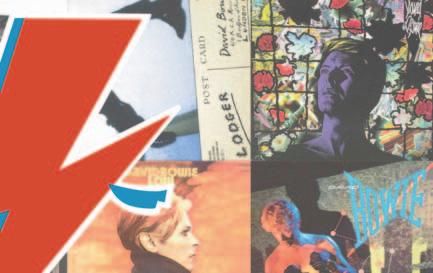 BY NATHAN RHIND Heights Senior Staff
BY NATHAN RHIND Heights Senior Staff
We are living in the age of the personal brand. Whether it be securing a spot at an elite university or receiving a lucrative job offer, our educational and professional aspirations are increasingly tied to our ability to craft specific, targeted personal images. While our aim to craft consistent brands is often well-meaning, what happens when we sacrifice our innate curiosity in this pursuit? Ultimately, is there something to be said for being a jack of all trades—even if one is a master of none? To find out, we can perhaps look to an unlikely source: the eccentric artist David Bowie.
Over the course of his career, Bowie inhabited many personas in a perpetual act of self-reinvention and artistic evolution. For our purposes, let’s focus on three of his best-known characters—Ziggy Stardust, The Thin White Duke, and, while not a specific persona per se, what I will call Berlin-era Bowie. By following these characters’ stories, we will investigate Bowie’s evolving ideological and artistic inclinations and try to pin down the real “Bowie brand.”
On June 16, 1972, Bowie released The Rise and Fall of Ziggy Stardust and the Spiders from Mars—a concept album that traces the arrival of an androgynous alien rock star sent to save Earth from an impending apocalypse. Through the Ziggy persona, Bowie glorified sexual
liberation and rebelled against the status quo. In other words, the Ziggy persona allowed Bowie to challenge the prevailing gender norms of the time. Bowie’s Ziggy character is perhaps not so much an alter ego as it is an expression of his authentic ego—someone freed from societal norms and expectations. This optimistic attitude, however, would not last.
On Jan. 23, 1976, Bowie’s 10th studio album, Station to Station, was released. The opening lines of the ominous first track announce the arrival of Bowie’s darkest persona. In the titular track, Bowie sings, “The return of The Thin White Duke / Throwing darts in lovers’ eyes.” Leaving behind Ziggy’s idealism and the liberated gender politics of glam rock, Bowie turns to inhabiting the cynical, cold-hearted Thin White Duke. Fueled by his spiraling cocaine addiction and flirtations with the occult, the album is a haunting soundscape of paranoia. Troublingly, Bowie also expressed sympathy for fascism during this time period. Although Bowie would later wholly disavow these views and express regret for his erratic behavior—calling the Thin White Duke a “nasty character indeed” and these times “the darkest days of my life”—Bowie’s behavior during this period is still a stain on his career and reputation. To escape the abyss, Bowie would travel to Berlin—with an equally drug-addicted and mentally unstable Iggy Pop—where he would experience an artistic and spiritual rebirth.
On Oct. 14, 1977, Bowie released Heroes, the second release of his famed Berlin Trilogy which also includes Low and Lodger. Inspired by the German electronic scene and with contributions from the ambient music pioneer Brian Eno and King Crimson guitarist Robert Fripp, Bowie and his producer Tony Visconti would craft one of his best albums. Although the dark, industrial soundscapes of Station to Station resurfaced on this album, Bowie’s lyrics were imbued with vitality rather than soulless paranoia. Take the titular track “Heroes” for example. The themes of hopeless romanticism and the possibility of true love “just for one day” come from

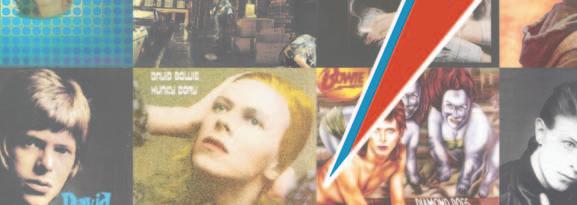

Bowie witnessing his producer embrace his lover next to the Berlin Wall. With Heroes, Bowie enters another chapter of artistic reinvention which coincides with his spiritual renewal and triumph over his cocaine addiction.
Throughout the rest of his career, Bowie would create more characters in his relentless pursuit of self-knowledge. Let’s Dance sees Bowie don a sleek satin suit under the “serious moonlight;” Scary Monsters (and Super Creeps) resurrects Major Tom; and—in a final act of performance art—Bowie declares himself a “Blackstar” on the studio album by the same name, released two days before his passing. Bowie’s artistic reinventions
weren’t contrived. They were part and parcel of his exploration of the many facets of his personality. What emerges from a study of Bowie’s characters is not a wholly good or bad man. It is a human being with virtues and vices, strengths and weaknesses.
As professional success becomes increasingly predicated by our ability to construct viable, polished brands, I am worried we are losing sight of the path to self-knowledge. Unless we indulge our curiosity and satisfy our itch for exploration, how can we know our true selves? True authenticity is found not by stagnancy but continual reinvention. Explore. Learn. Evolve.
with tuberculosis, head for Japan.
the reading, history department associate professor Arissa Oh and English professor Elizabeth Graver facilitated a Q&A session, fielding questions from over 500 online attendees. Lee expanded
A9 THE HEIGHTS MONDAY, MARCH 1, 2021
‘IDK
Contained Chaos
[What
GRAPHIC BY OLIVIA CHARBONNEAU / HEIGHTS EDITOR
SCREENSHOT BY KATHERINE CANNIFF / HEIGHTS EDITOR
SCREENSHOT BY ASHER KANG / FOR THE HEIGHTS
Professors Arrisa Oh, Elizabeth Graver, and Min Song talk ‘Pachinko,’ author Min Jin Lee’s acclaimed 2017 book.
‘IDK [What This Is]’ cast inhabits specially designed cubbies while focusing on executing overlapping dialogues.
Docuseries Analyzes Woody Allen Abuse
There’s no denying that Woody Allen is a cinematic figurehead. Considered by many to be one of entertainment’s most prominent triple threats, he has written, directed, and starred in over 70 films in the last six decades, cultivating a niche, neurotic, New York sense of humor that has inspired generations of filmmakers after him.

When you hear the name Woody Allen, you might think of sharp wit, excruciatingly self-aware writing, and a small, anxious, anti-leading man full of insecurity and cultural genius. You also, however, can’t help but think of a
man that married his then 21-year-old stepdaughter Soon-Yi Previn and stands accused of years of sexual abuse against his own child and other minors. The name Woody Allen, despite its legendary status, has slowly become synonymous with first-rate perversion and a gross abuse of power. HBO’s new docuseries, Allen v. Farrow, uses first-hand interviews and unseen home videos to examine how such a beloved figure could be capable of such vile things.

Stories of Allen’s fixation with minors have peppered the media for years. Dylan Farrow, his adopted daughter and alleged victim, first accused Allen of sexual abuse in August of 1992 when she was 7 years old. It was around the same time that Al-
















len was discovered to have engaged in an “affair” with Previn after naked polaroids of the young woman were found in his personal belongings by his then-girlfriend and Previn’s mother, actress Mia Farrow. Despite the sensational and salacious nature of these events, Allen somehow avoided significant backlash for these claims and continued making films for many years unscathed. It was not until the mobilization of the #MeToo movement that his past actions began to be heavily scrutinized by the media and his fanbase. In the years following, an increasing suspicion began to build around the question of Allen’s guilt, with many celebrities and past collaborators either supporting or separating themselves from Allen’s dwindling reputation. That brings us to Allen v. Farrow, an exposé on the disgusting truth and details of Allen’s alleged abuse.
To put it bluntly, it’s stomach-curdling. The first episode opens with Dylan describing her seemingly idyllic childhood with Mia and Allen, full of movie sets and siblings galore, but it slowly shifts into a sickening tale of pedophilia as she recounts her abuse at the hands of Allen with vivid detail. Like other documentaries designed to expose the corrupt nature of public figures, interviews with witnesses and sources close to the victim follow.
Dylan’s mother Mia and her brother Ronan Farrow, a Pulitzer-Prize winning
journalist who reported on the #MeToo movement, are given ample amounts of screentime. They discuss the strange nature of Allen’s fascination with the toddler-aged Dylan and the subsequent effects it had on her emotional well-being.
It’s a little jarring to see such famous people speaking so frankly about an arguably even more famous person in a documentary format, but it ultimately goes to show the extent to which power protects perpetrators of sexual violence. Despite both Mia and Ronan’s relations to Allen, they have continued to defend Dylan, even when her statements have been publicly scrutinized.
Allen v. Farrow is a story about the forgotten victims of notable abusers. It is meant to uncover not only the difficulty of sexual trauma itself, but also the issues victims face in being believed at all. The explosive nature of Allen v. Farrow allows for a captivating narrative, and given the story’s high-profile subjects and sensitive nature, in the coming weeks it is likely for the series to gain more traction.

This is a story that has begged to be told and heard for many years in Hollywood. Now, it’s finally getting the audience it deserves. Allen might have been able to live without facing his past, but by the time audiences finish watching the Allen v. Farrow docuseries, I doubt that will be the case much longer.
‘Minari’ Depicts Asian American Journey


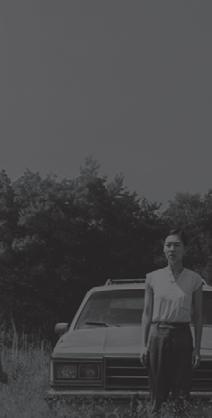

 BY ALICIA KANG Asst. Arts Editor
BY ALICIA KANG Asst. Arts Editor
Director Lee Isaac Chung’s film Minari draws on his life as a little boy in Arkansas. Jacob Yi (Steven Yeun) has big plans to establish a farm and make something of himself, while his wife Monica (Han Ye-ri) wants a stable life for their children. Both left Korea to start a life together in the United States with their daughter Anne (Noel Cho) and son David (Alan Kim)—the star of the movie and the surrogate for Chung’s story. The Yi family soon experiences firsthand how difficult—and almost impossible—it is to create a new life and home in a new environment. Money’s tight, David has a heart problem, and their situation only grows tenser when Monica’s mother, Soonja (Youn Yuh-jung), comes to live in their trailer house.
The film amazed audiences at the Sundance Film Festival in January 2020 before its limited release in December 2020.
Minari is such a powerful work of art that it’s difficult to know where to begin. The central focus for most viewers will likely rest on the cast’s masterful performances. Yeun portrays exactly how a Korean American immigrant father can obstinately follow his own path and brush off heavy questions about how the family is supposed to find stability in their future. Ye-ri, as a perfect complement, knows how to ask these piercing questions while still maintaining a quiet and composed exterior. Cho understands
which scenes demand a playful older sister and which ones require a more complex, nuanced little girl who’s having struggles of her own. And at the heart of it all, Kim soars with a performance that doesn’t seem like an act at all. He so excellently embodies a spirited yet tame youngest child, to the point that it’s hard to believe the cast onscreen isn’t his true family.
Minari’s cinematography and scene sequences create the effect of watching a reel of memories—fitting the work’s partly autobiographical nature. For example, when David goes to sleep one night, we aren’t shown the rest of his parents’ fight. Instead, we wake up with David the next morning, and David’s parents tell us how things are going to be from now on.
Short takes and montages interrupt longer scenes that typically dominate quiet films like Minari. This pacing further enhances the feeling of looking into David’s memories while working in enough tension to avoid long stretches of silence and inaction. Rather than solely relying on lengthier scenes to make Minari feel like an art film, Chung showcases little moments that punctuate the family’s daily life by showing Monica changing bed sheets or the children drinking Mountain Dew.
There’s a quiet tension in Jacob and Monica’s fights, particularly since the audience is shown their plight through the eyes of David—their anxious child. Minari, however, is also filled with tiny gestures of


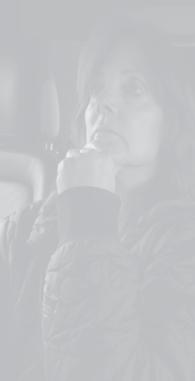
love and parental support. Monica doesn’t show her care for Jacob through a kiss or a hug. Instead, she washes his hair for him when he’s too tired from working on the farm all day to lift his arms above his head. And Jacob doesn’t extend comforting words or encouragement, but rather an offer to attend church next Sunday as a family.
These little moments delve into a deeper kind of love that might not necessitate, nor even allow, outward affection. Their marriage, like many immigrant families’, relies on steadfast priorities, compromises, and trust. Though David and Anne may feel anxious when their parents fight, they ultimately seem to know that their mom and dad would do anything to support them.
MOVIE
Non-Korean-American audiences might not recognize or feel affected by all of the distinctly Korean images in the film, but it’s precisely these moments that strengthen Minari’s emotional impact. Minari isn’t made to reflect the experiences of white American audiences and families.
Rather, the film spotlights the unique challenges that come with striking entirely new ground and trying to love each other through anything. Chung knows what he’s creating when he directs his actors, and he knows what the tiniest mannerisms will mean to his audience. This level of sophistication brings Minari out from the genre of culturally empowering movies and into the world of culturally significant art.
In preparation for his fourth studio album, Collections from the Whiteout , expected to drop in late March, Ben Howard released two more singles from the project: “Far Out” and “Follies Fixture.”

These two singles follow closely on the heels of two other songs from the album that were released a few weeks ago and give a good indication of the sound, style, and overall feeling of the new album.
“Far Out,” which features a graceful bassline and a laidback electric guitar, is the more lively of the two new tracks, although that doesn’t say much given Howard’s often soft-spoken music.

“Follies Fixture” relies on a dreamy synth, an acoustic guitar, and layered vocals to deliver a reflective track that will serve as the lead song for Howard’s upcoming album.
Ultimately staying true to the nature of his songwriting, Howard keeps the lyrics of both singles abstract.
By leading with this song writing method, Howard leaves the singles’ interpretations up to the listener. The two new releases will also build anticipation for the rest of Howard’s upcoming album Collections from the Whiteout
Billie Eilish Explores Song Writing Process
 BY SHAUN TAXALI Heights Staff
BY SHAUN TAXALI Heights Staff





In 2019, pop-alternative star Billie Eilish released her album WHEN WE A LL FALL ASLEEP, WHERE DO WE GO? and took her newfound stardom to astronomical heights. That year she won five Grammys and earned several hits on the Billboard charts. The brand new, fly-on-the-wall documentary Billie Eilish: The World’s A Little Blurry on Apple TV+ aims to show audiences exactly what being a world-famous artist is like at the age of 19.

Unfortunately, director R.J. Cutler focuses more on concert movie clichés, such as meet and greets and global performances, rather than on who Eilish is and the messages she tries to communicate through her music. Although the movie feels dragged out for two and a half
hours, there are some poignant moments of Eilish’s.
She explains her deeply personal thoughts on her music and her complicated loving and working relationship with her parents and brother—who all still live under the same roof in the Highland Park neighborhood of Los Angeles. But, these moments are spread too thin, failing to give audience members a vivid portrait of a teenage pop star whose popularity is largely tied to her emotional connection with a Gen Z fan base through vulnerable lyrics that tackle themes of mental health.
The documentary attempts to place audience members next to Eilish and her brother, Finneas—who is also Eilish’s personal producer. The film shows them working on her debut album in a makeshift recording studio, which happens to be a guest bedroom in their childhood home. A camera is tucked away in the
corner of the cozy bedroom filming Eilish finishing a record, as there is not enough space in the recording studio for a camera crew to be there. The audience is placed in this space—a fly on the wall to Eilish’s creative process.
It is immediately clear that the brother-sister music duo are powerfully synced collaborators, as they are seen developing song ideas and honing their creative process throughout the film. They work as a team, and some of the most invigorating parts of the film show the progression of the two musicians creating personal art outside of the public eye. In the film, Eilish shares a book of poetry and sketches that serve as inspiration for her music, describing her battles with depression and Tourette syndrome, showing how even with commercial success at a young age, her music is still exactly that, her music.
At one point in their kitchen, Finneas admits to their parents that he is looking to make a hit—at least that’s what Interscope Records wants from him and his sister. Eilish interjects, claiming that she simply wants to make what she wants, further speaking to her desire to create something expressive of her personal experiences, even if her producer wants her to make music that’s more commercial.
Outside of Eilish’s newfound fame, Cutler also tries to present her as a typical teenager. Throughout the film, Eilish is seen at the DMV, FaceTiming her unenthusiastic boyfriend, and eventually dealing with heartbreak before a live performance in New York. But these
moments are always overshadowed by the new lavish reality Eilish now faces as a young burgeoning celebrity.
Later on, while recording her song for the upcoming James Bond film, No Time To Die, Eilish claims that she doesn’t want to belt vocally too much out of fear of people criticizing her voice on social media. Cutler shows how despite her superstardom, Eilish still endures the trivial realities that every 17-year-old faces.
Instead of diving into Eilish and Finneas’ creative sides, most of the film shows Eilish and her brother, accompanied by her calm and supportive mother, plowing through an exhausting global tour. Eilish’s many performances of her popular hits are intriguing but unfortunately overshadow the more interesting story of Eilish herself.
While backstage, Cutler takes the same approach as he did in the makeshift recording studio, leaving the camera with Eilish and her team, letting the audience feel like it’s in the room with the young musician. With most scenes dedicated to the colossal amount of time Eilish spends on tour, the film fails to sustain the emotional substance found in the shots where Eilish spends time at home and with her family.
Ultimately, viewers may be left wanting more even after the film’s long duration. Nevertheless, audiences can be left with an immense respect for both Eilish’s talents and her ability to balance her identity as a teenager and her celebrity status.
When the light yet powerful voice of Lila Iké speaks, the world shall listen.
The Jamaican songbird’s reggae track “Thy Will” warns that the unjust violence she has witnessed in Jamaica will not be forgotten. The accompanying music video, which premiered on Feb. 23, mirrors the song’s simple, effective message that calls for change.

Like old school reggae, “Thy Will” enlists a choir for supporting vocals, complementing the choice to set some of the music video in a church. Although the song was released on her album The ExPerience in May 2020, the visuals for this version of the prophetic track feature fellow Jamaican artist Skillibeng.
Lyrics such as “And when we’re one / This is when we’ll overcome” clearly aim to inspire listeners by emphasizing themes of unity—a key to creating change for Iké. Iké embodies a revolutionary spirit, as news headlines detailing the injustices people in her community have faced interrupt the video and clips show her taking to the streets to protest such injustices.
The varied lighting in some scenes makes the visual effects and message more prominent, especially when juxtaposed alongside shots of the protest, which are in black and white.
The past year has seen music videos centered around social justice from dozens of Black American artists such as Teyana Taylor’s “Still” or Alicia Keys’ “Perfect Way To Die.” Iké’s video reminds the world that the fight against systemic racism and corruption is a global struggle. While her video specifically highlights issue s of social justice in Jamaica, the song does not explicitly reference the country, allowing many audiences to relate to the music.
Although issues of social advocacy are important and oftentimes heavy topics, there is room for celebration. When the beat drops toward the end of the song, neither Iké nor the churchgoers can avoid the musical whims of freedom as they dance through the song’s ending.
THE HEIGHTS
PHOTO COURTESY OF HBO MAX
DICK
ZIERING DISTRIBUTED BY HBO MAX RELEASE FEB. 21, 2021 OUR RATING TV SERIES
‘ALLEN V. FARROW’ KIRBY
AND AMY
PHOTO COURTESY OF A24
RELEASE FEB. 12, 2021 OUR RATING
‘MINARI’ LEE ISAAC CHUNG DISTRIBUTED BY
A24
PHOTO COURTESY OF APPLE TV+ ‘THE WORLD’S A LITTLE BLURRY’ R. J. CUTLER DISTRIBUTED BY APPLE TV+ RELEASE FEB. 26, 2021 OUR RATING
MOVIE
MONDAY, MARCH 1, 2021
‘THY WILL’ LILA IKÉ
& ‘FOLLIES
KIERAN WILSON
‘FAR
OUT’
FIXTURE’ BEN HOWARD
A10 BY GRACE MCPHEE Heights Staff
TONIE CHASE
SINGLE REVIEW
MUSIC VIDEO
By Olivia Nolan Heights Staff
Boston College women’s hockey defender Cayla Barnes’ defensive zone prowess is well documented. She ranks No. 5 in the Hockey East for blocked shots and sports a plus-minus rating of +10. In the Eagles’ Sunday matchup against UConn to open the Hockey East Tournament, Barnes showcased her offensive talent as well. She earned what was likely BC’s best offensive chance of the game when she rang the puck off the Huskies’ goalpost in the midst of a scrum in front of UConn netminder Samantha Carpentier-Yelle. Barnes also recorded the Eagles’ only score of the game with six minutes left in the third period, when she wound up for a slap shot that lasered over the shoulder of Carpentier-Yelle.
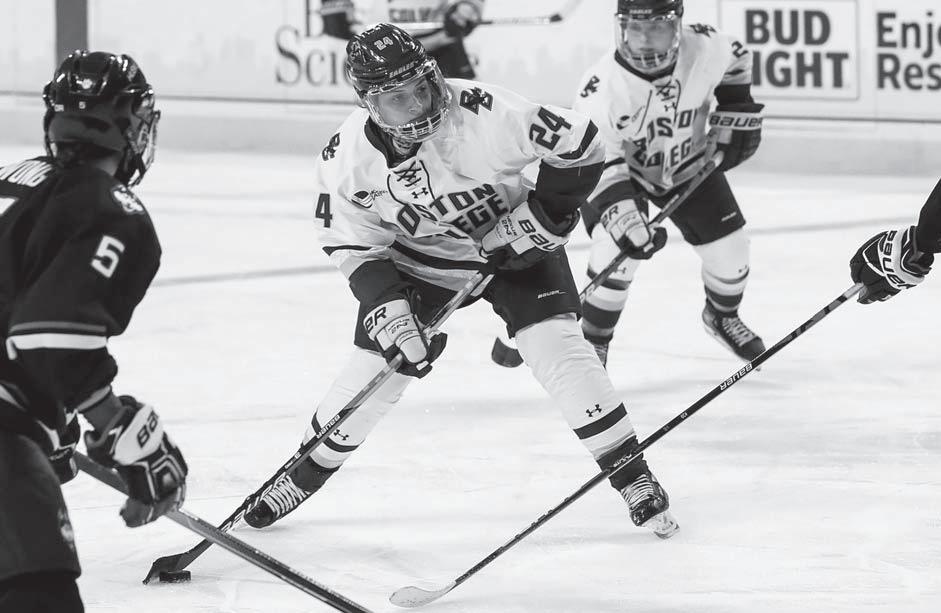
Even so, BC couldn’t rally from its three-goal deficit, and the Eagles fell to the Huskies 5-1 in the quarterfinals of the Hockey East Tournament. Each period told a different story, as the No. 6 Eagles (14-5) came out flying in the first period but struggled to hold off UConn (9-9-1) throughout the final two periods of the game.
“We just didn’t have it today,” BC head coach Katie Crowley said in her postgame press conference. “Obviously that was tough.”
Kelly Browne looked strong throughout the first period, and stel-
lar defensive performances by Hadley Hartmetz and Sidney Fess aided BC’s potent offense. The Eagles couldn’t solve Carpentier-Yelle in the first frame, however, and when the Huskies took the ice for the second period, it was an entirely new game.
“We weren’t able to [capitalize] on the few chances that we did have, and [UConn] had a lot of energy, and it seemed like we didn’t,” Crowley said. “UConn, I don’t care what their record is, they’re a good team. They play hard, they play together, and they work for a full 60 minutes no matter what.”
UConn was firing on all cylinders throughout the second period, and the Huskies earned three goals to show for it. The Huskies took advantage on a 2-on-1 early in the period, as Morgan Wabick poked the puck through the five-hole of BC goaltender Abigail Levy, who struggled to see the puck all game and let in an uncharacteristic five goals on the night.
Most notable, however, was the lockdown team defense that the Huskies put forth against an Eagles offense that ranks second in the Hockey East in goals scored.
Though the Eagles managed to garner 16 shots on goal throughout the second period, the majority of those shots came from outside the slot, and Carpentier-Yelle easily turned them away.
BC is carrying a young team this season, and some of Sunday’s kinks can be attributed to the inexperience
of a team with only one senior.
“We haven’t been through this stuff … we need to learn how to mentally make that switch in our brain that this is now a playoff game,” Crowley said.
As the third period wore on, BC began to take more offensive risks in an effort to narrow the deficit and get a goal on the board.
Though Barnes skillfully put home her goal with 6:04 to go in the game, UConn bookended her tally with
two breakaway goals that Levy could not stop.
A pair of icing calls in the final five minutes worked out in UConn’s favor, as the stoppages in play meant that BC could not garner much offensive momentum.
Hartmetz closed out the game with a well-placed shot on UConn’s net, but Carpentier-Yelle made the save and the Huskies came away with a hard-fought win.
Looking ahead, BC remains hope-
ful for a bid to the NCAA Tournament.
Without a win in the Hockey Eas t Tournament, an automatic bid is out of the question, but the team’s current No. 6 national ranking coul d be enough to get the Eagles an atlarge bid.
“I think we’ve had a very goo d year,” Crowley said. “We’ve prove d that we can play in that tournament. … We’ve proved with our body o f work that we can be there.”
Sheehan Strikes Out Nine To Win Series
By Lucas Girardi Heights Staff
Coming off a 34-run opening series at Charleston Southern, Boston College baseball rode its momentum right into its first series against an ACC opponent—and its first ranked opponent—of the 2021 season.
After splitting the first two games of the series, with BC (5-1, 2-1 Atlantic Coast) taking the series opener and No. 25/11 Duke (3-4, 1-2) winning the second, the Eagles hung tough with the Blue Devils to take home the series finale by a final score of 5-2 in what was much more of a defensive battle than the first two games.
Junior right-hander Emmet Sheehan impressed with another strong performance on the mound, striking out nine batters for the second week in a row.
He pitched a solid six innings of work for the Eagles, only giving up two runs, one walk, and six hits, and he retired six of his last seven batters faced.
The game was tight most of the way through, as Duke struck back with a run in each inning that BC
scored except for the seventh. After starting the top of the second with a single, a double, and a walk, the Eagles only scraped out one run in the inning.
First baseman Jack Cunningham led off with a single, and he tried to reach home on sophomore second baseman Luke Gold’s double but was thrown out.
Gold then advanced to third on a wild pitch and scored the only run of the inning on a fielder’s choice thanks to catcher Peter Burns’ ground ball.
Cunningham posted an impressive stat line after struggling last weekend against Charleston Southern with no hits across BC’s opening three games.
In the series finale against Duke, however, Cunningham went a flawless 4-for-4 with two doubles to end the series hot. Across the weekend series, he went 8-for-12 on hits. Sunday’s game was the first four-hit game of his career.
Duke wasted no time in tying the game at one apiece, as outfielder Peter Matt led off the bottom of the inning, and then another double down the left-field line by Chad Knight drove him home.
BC took back control of the game
in the fourth inning thanks to a two-run home run by Gold to drive Cunningham in after he reached on a double. Both hits came against freshman left-hander Josh Allen, who came in to relieve junior righthander Jack Carey at the start of the inning.
The Blue Devils responded with a solo home run of their own by RJ Schreck in the bottom of the fourth to stay competitive while trailing 3-2.
After scoring the first run of the game following his double, Gold showed off his timely hitting yet again with the go-ahead home run. He went 2-for-4 on the day and has at least one hit in every game but one this season, and he has notched nine RBIs and a standout .360 batting average across the Eagles’ first six games.
BC sealed the win by putting up another two runs in the seventh.
Right fielder Dante Baldelli led off the inning with a single, and two batters later, junior center fielder Sal Frelick nailed a home run to right field to provide the Eagles with a much more comfortable three-point cushion at 5-2.
That score would hold until the end of the game, as right-handed
pitcher Alex Stiegler recorded the save, striking out five batters and giving up no runs through three innings.
Stiegler is a graduate transfer at BC after a four-year career at Yale and has been instrumental out o f the bullpen this season, allowing just one run in 8.1 innings of work and striking out 13.
Frelick leads the Eagles’ batters in hits with 12 across the Eagles’ first six games, batting an impressive .429. Infielder Cody Morissette, who went 0-for-3 on the day, continues to struggle to find his groove, batting .136 with only three hits so far this season.
The Eagles have now scored 52 runs through their first six games for a stellar average of over eight and a half runs per game, an increase o f nearly three runs per game over the 2019 season.
BC’s 5-1 start is the best it has seen since 2016, when the Eagles opened their first two series o f the season undefeated through six games.
The Eagles’ series win over the Blue Devils was BC’s first victory over a ranked opponent since winning two out of three at No. 19 FSU in 2019.
Prolific Offense Lifts Eagles Over Irish on Senior Day
By John Scrimgeour Heights Staff
The long-held tradition of Senior Day in college sports is perhaps even more meaningful this year. The class of 2021 has had two seasons affected by the COVID-19 pandemic, which makes honoring this year’s seniors that much more important. Boston College men’s basketball showed just how much its seniors mean to the team against Notre Dame on Saturday.

Saturday’s 94-90 win over Notre Dame was a high in a season full of lows for the Eagles. BC has suffered cancellation after cancellation, felt the w eight of the firing of a seven-year head coach, and prior to Saturday’s w in, had won just one ACC contest all season long.

“It was a tremendous win for all the guys, especially the seniors,” said interim head coach Scott Spinelli in his postgame press conference. “It really is gratifying to watch their locker room celebration and how they responded after the win.”
BC (4-13, 2-9 Atlantic Coast), currently sitting in the cellar of the ACC,
notched its second conference win of the season with two games remaining in the regular season.
The last few weeks have been a roller coaster ride for BC, including the firing of head coach Jim Christian and guards Wynston Tabbs and Rich Kelly electing to enter the transfer portal.
The loss of Kelly further thinned an already undermanned BC roster, but it gave the chance for the “martians,” the nickname given to BC’s five walk-ons, to see time on the court.
Seniors Sam Holtze and Will Jackowitz made their first-ever collegiate starts, while James Karnik and Frederick Scott also saw playing time.
Holtze, who walked onto the team as a freshman, made the most of his minutes by opening up the game with a 3-pointer, getting a steal, and then drawing a charge all in the first two minutes of play.
The game also marked a special celebration of Steffon Mitchell’s storied career. The senior was named to the 2019-20 All-ACC and All-Defensive teams, becoming the first BC player to earn the latter honor. Coming into Saturday’s game, Mitchell was fifth on the team in scoring but led the
Eagles in rebounding with 116.
On Saturday, Mitchell recorded nine points, eight rebounds, and two steals.
“For all the times he’s dove on the floor and played to win games where maybe we came up short, it’s nice to send him off like that,” Spinelli said about Mitchell.
The last time BC and Notre Dame met, the Eagles fell to the Irish 7080. This time around, BC focused on getting to the basket, and the Eagles were more careful with the ball, turning it over just five times compared to the nine times they turned it over in January’s matchup.
Redshirt junior guard Makai Ashton-Langford shined for the Eagles, scoring 16 points, including 4-of-6 from three, and dishing out six assists.
“My mindset was to be more aggressive,” Ashton-Langford said. “My teammates keep pushing me to get to the basket and knock down the open shots when they come.”
Ashton-Langford’s younger brother, DeMarr Langford Jr., also played well for the Eagles, scoring 17 points and hitting four crucial free throws in the closing seconds of the game.
Scott, a graduate transfer from
Rider, made a huge impact in his first game back from injury, scoring 18 points on 6-of-9 shooting. Jay Heath continued his stellar play, leading BC with 19 points.
Junior guard Prentiss Hubb carried the scoring load for the Irish, finishing with 28 points on 12-of-19 shooting.
Though the win came in Spinelli’s debut, the coach was quick to reiterate that the win was about the guys, not him.
“The record isn’t what any of us
wanted it to be,” Spinelli said. “But every time these kids got knocked down, they got back up. It speaks to their character and who they are as people.”
Spinelli and his players were also quick to give credit to Christian.
“Shout out to Jim Christian. He set all of this up for us,” Ashton-Langford said. “They bring two different types of energy to the game. [Spinelli] is more of a jumpy guy, and that’s what it took for us to win today.”
BC
Opener To UConn
Drops Hockey East Tournament
MONDAY, MARCH 1, 2021
PHOTO COURTESY OF BC ATHLETICS
A11 UConn Boston College 5 1
Despite entering the game as the No. 2 seed, BC fell 5-1 to lower-ranked UConn in the Hockey East quarterfinals.
Dame Boston College 90 94
Boston College Duke 5
2 Notre
MICHAEL DWYER / AP PHOTO
THE HEIGHTS
Frederick Scott recorded 18 points in BC’s second conference win of the season.
CATALYSTS
I By Emma Healy Sports Editor Asa Ackerly Assoc. Sports Editor Ethan Ott Asst. Sports Editor
Casper Augustus Ferguson, the first Black student at Boston College, graduated from BC in 1937. In the 10 years after Ferguson’s graduation, only six Black students earned a BC diploma. As the first Black student at BC, Ferguson was a trailblazer, but his presence on campus was only the beginning of a nearly century-long—and still ongoing—fight for full integration and racial equality at BC. Since the 1930s, Black athletes, coaches, and athletic administrators have frequently led the fight against racial discrimination on the Heights.
In the following 60 years after receiving his degree, Ferguson returned to the Heights only twice: once to see Ernie Davis, a Syracuse player who became the first Black player to win the Heisman Trophy, and once for an AHANA Alumni Association dinner in his honor in the ’90s.
One of the six Black students who followed Ferguson was Lou Montgomery, BC ’41, the first Black athlete at BC. Montgomery arrived just a semester after Ferguson’s graduation. He was a running back for the football team and one of three Black students in his class. Six times throughout his four years on the Heights, BC barred him from competing against southern schools because of the “Gentlemen’s Agreement,” which competitors who refused to play against Black athletes requested and BC complied with. Three of those games were home games, and two were bowl games.
Heights coverage at the time reported on BC’s treatment of Montgomery but did so without denouncing it. In 1939, The Heights described discrimination against Montogomery as “foolish and time-worn bias.”
In choosing to attend BC, Montgomery turned down an offer from UCLA, where he would have played football with Jackie Robinson, who arrived in Southern California two years after Montgomery first took the field with the Eagles. BC football arguably reached its peak during Montgomery’s time, finishing with a perfect season and a debated national championship during his senior year in 1941. Montgomery, however, was not allowed to play in the Sugar Bowl, as it was against southern opponent Tennessee. Despite the adversity he faced every time he took the field, Montgomery was renowned for his love for football and commitment to the game. In 1997, Montgomery was posthumously inducted into the BC Varsity Club Hall of Fame, and his jersey was retired at Alumni Stadium in 2012.
Montgomery was a trailblazer, but it took decades before other Black student-athletes had a chance to walk in his footsteps. In 1955, there was only one Black player on the Eagles’ football team. Larry Plenty, also a running back, averaged 5.7 yards per carry on 42 attempts during the 1955 season. He also played punter and averaged 28.4 yards per punt. Plenty was
a two-sport athlete, and during the 1957 baseball season, he led the team with a .389 batting average.
“[Plenty is] the only member of our team that has lived up to my expectations,” then-head baseball coach Johnny Temple told The Heights after a disappointing 1957 season. “There is nothing at all surprising about Plenty’s fruitful production this season, for he possesses all the necessary requirements demanded of a great athlete: The arm, speed, physique, batting power, and above all, the natural ability.”
The Heights revisited Plenty’s standout 1957 season in a 2002 article entitled “Diversity Finds a Place at BC,” which also featured John Austin, BC ’66.
Twenty-one years after Montgomery’s graduation, Austin arrived at BC in 1962 as the Eagles’ first-ever Black basketball player. Austin played on the varsity team for three years and is still one of the greatest players in school history to this day. He still holds program records for career scoring average with 27.1 points per game over three years, season scoring average of 29.2 points per game in 1963-64, and points in a single game with 49 against Georgetown.
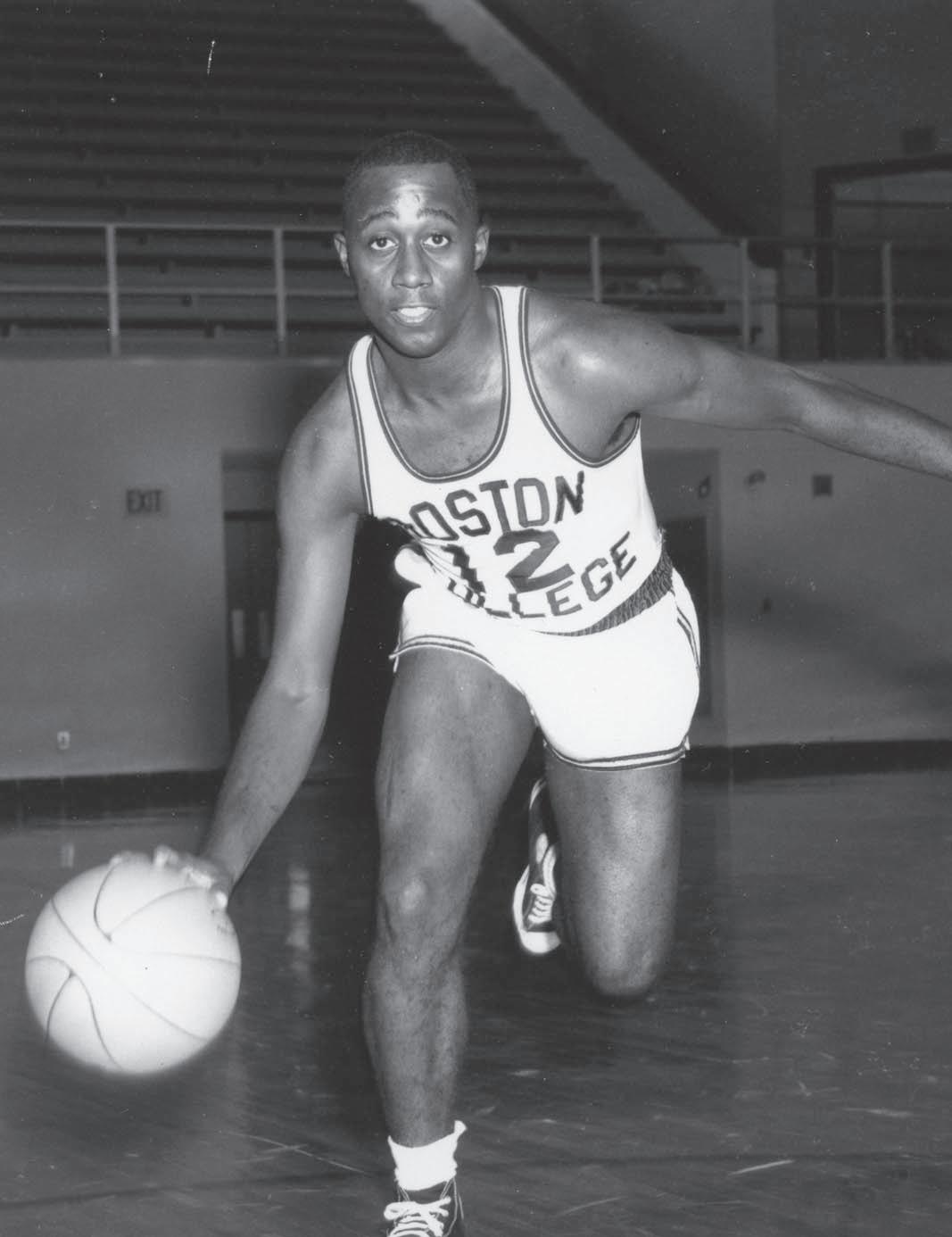
Austin’s time as an Eagle began a year after Celtics legend Bob Cousy arrived at BC as the Eagles’ head coach, and the two played a major role in rebuilding BC’s basketball program.
“[Austin] was probably the most skilled
“If a Boston College basketball fan should happen to miss a game, there are two questions which he will inevitably ask—What was the score? and, How many did John get?” a Heights article from 1966 read.
Austin led BC to two National Invitation Tournaments during his time as an Eagle. As not only the first Black player but also arguably the best guard in program history, Austin paved the way for countless athletes to follow and helped put BC basketball on the map. Austin died in early November of 2020, but his legacy lives on, both on the court and in the record books.
It took another seven years after Aus-
player
He graduated as the program’s all-time scoring leader and sits among the top 10 today with 1,845 career points. He was a two-time All-American—BC’s first-ever— and holds the record for the first, second, and third-most points scored in a game.
tin’s graduation for a Black female athlete to make her mark on the athletics program. When Doxie McCoy arrived at BC as a freshman in 1973, the school had been coed for just three years, Title IX had been in place for less than a year, and there was no women’s ice hockey team. While there is no official documentation of who the first Black female athlete at BC was, McCoy is a likely candidate.

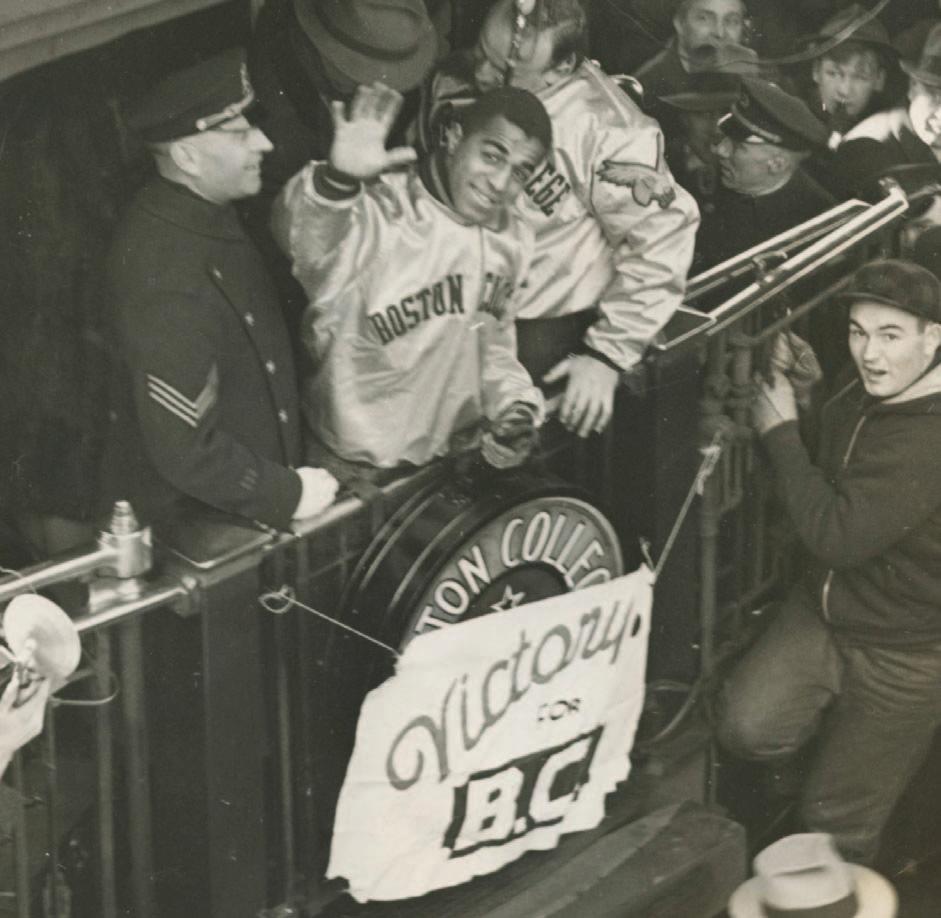
McCoy was a multi-sport athlete
“When I came to Boston College, I was used to being in the minority,” McCoy said to BCEagles.com. “But by the same token, I was never held back in terms of pursuing the things that I wanted to do. Because I thought, if not me, then who will? I’ve never been afraid to try to break barriers and encourage any student who feels like they can contribute and feel like if they’re the only one then don’t be afraid to be the only one because we need the first only one.”
McCoy’s involvement on campus did not end with athletics. She founded a minority-led newspaper called Collage and was a sports writer for The Heights in keeping with her communication major. As editor-in-chief of Collage, McCoy served as a voice for underrepresented students on campus, at one point calling out the BC administration for removing the Black Talent Program meant to recruit more Black students. McCoy was also involved in protests at BC urging the administration to increase the campus’ minority population.
Almost 50 years later, BC is still making strides toward racial equity. Martin Jarmond’s hiring as athletics director in 2017 was barrier-breaking for a number of reasons. First, Jarmond was the youngest AD in the Power Five. Second, he was BC’s first ever AD of color, and at the time, BC employed no minority head coaches. Jarmond’s time as AD was short—he departed for UCLA in the summer of 2020— but his impact was lasting. He oversaw the transition of power between Steve Addazio and Jeff Hafley at the head of the football program. He also hired women’s soccer head coach Jason Lowe, BC’s only current Black head coach.
From practically his first day on the Heights, Jarmond began to roll out never-before-seen initiatives across the athletics department. From introducing alcoholic beverages in Alumni Stadium to overseeing the massive construction project of the Pete Frates Center on the Brighton Campus, Jarmond was everywhere.
“When you’re in the competitive world of college athletics, it’s never enough,” Jarmond said in a 2018 interview with The Heights. “That doesn’t mean that we’re going to build the Taj Mahal, but we need to put our coaches and our student-athletes in positions where they can be successful.”
Just months after the addition of Jarmond to the athletics administration, BC hired Jocelyn Gates, the highest-ranking
“I am here for every student-athlete, there is a special place in my heart for the student-athletes of color,” Gates said in a 2019 interview with CollegeAD.com. “I feel like I need to be a voice for them and young administrators of color. They need to see a face like their own in administration and know they can do it too.”
Jarmond’s arrival at BC came 20 years after BC men’s basketball hired Al Skinner, the only Black head coach of a revenue sport in the school’s history. Before starting at BC, Skinner played a long career in the NBA and had head coaching experience at the University of Rhode Island. Skinner’s first three seasons at BC combined for just 12 wins in the Big East, but he turned his luck around the next year when he led the Eagles to a Big East title–their first regular-season title in 18 years. The 2000-01 Eagles also earned a No. 3 seed in the NCAA tournament, and Skinner was named the NCAA Coach of the Year at the season’s close.
BC men’s basketball appeared in March Madness in six of its next nine seasons with Skinner at the helm. His 2005-06 team made it the farthest BC has ever gone in the NCAA playoffs, as its season ended in the Sweet 16. Skinner was fired in 2010 after his second season below .500. He is still the winningest coach in BC men’s basketball program history, and his firing remains controversial.
BC, along with other institutions, has also made progress in bringing change to areas of college sports that have remained largely exclusive to people of color. On Feb. 11, NCAA Division I Hockey announced the formation of a College Hockey for Diversity, Equity, and Inclusion initiative. A group of 27 people, including student-athletes, coaches, and administrators from all 11 Division I hockey conferences, leads the initiative.
BC defenseman Marshall Warren is one of the five members of the group from the Hockey East. Warren, who is the only Black member of the BC program and one of just a handful of Black players across all of Division I, posted on social media that he hopes the initiative will “create change within hockey as a whole.”
The announcement of the new initiative was the latest step in a year marked by the intersection of race, sports, and activism. In August, BC football opted to cancel practice in response to the police shooting of Jacob Blake in Kenosha, Wis. The decision came on the heels of a number of other boycotts by college football, basketball, and baseball teams across the nation. Instead of practicing, the Eagles met as a team and discussed issues of racial injustice.
“We decided not to practice today,” BC head coach Jeff Hafley said in August. “A bunch of things have obviousl y gone on in our country, and with the recent events that happened, we felt as a staff and as a team that it was best not to practice.”
While BC has come a long way since Ferguson’s first year on campus, there is still much room left for progress.
To continue progressing forward in racial equality within athletics, BC founded the Eagles for Equality initiative. The initiative includes a 14-person committee of student-athletes and aims to educate the BC athletic community and build a “more inclusive environment for all marginalized student-athletes and to enhance their experience at the Heights.”
“It is clear that the voices of student-athletes need to be heard now, more than ever, especially on critical topics such as inclusion, social justice and equality,” Athletics Director Pat Kraft said on BCEagles.com. “The creation of this outstanding committee will provide us all with guidance to create necessary and long-lasting change.”
PHOTOS COURTESY OF BC ATHLETICS From top to bottom: Lou Montogmery; Doxie McCoy and BC’s first women’s hockey team; John Austin
I coached at BC,” Cousy said in an interview, The Heights reported in 2002. “There were a lot of great players, but John had the most skill.”
during her time as an Eagle, taking advantage of recent Title IX changes to be a driving force behind the creation of BC’s first women’s ice hockey team and a member of the newly created field hockey team. Longtime great men’s hockey coach John “Snooks” Kelley tapped McCoy to be a founding member of the women’s ice hockey team despite the fact that she didn’t know how to skate.
Black female in BC Athletics, to assume the role of senior associate athletics director and senior woman administrator. She is also the departmental deputy Title IX coordinator. After just three years on the Heights, Gates was named FBS Administrator of the Year. A former student athlete, having played soccer at Howard University during her undergraduate years, Gates is intentional about advocating for student athletes of color.
MONDAY, MARCH 1, 2021 A12 THE HEIGHTS



























 By Brady Luck Heights Staff Indio Day Heights Staff
By Brady Luck Heights Staff Indio Day Heights Staff






























 BY NATHAN RHIND Heights Senior Staff
BY NATHAN RHIND Heights Senior Staff










 BY ALICIA KANG Asst. Arts Editor
BY ALICIA KANG Asst. Arts Editor


 BY SHAUN TAXALI Heights Staff
BY SHAUN TAXALI Heights Staff








